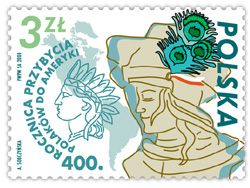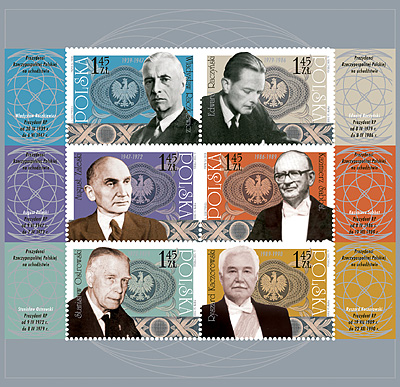| OFFER | |
| ISSUE PLAN | |
| CATALOGUE | |
| HISTORY OF STAMPS | |
| ONLINE WEB STORE | |
| STAMPS WITHDRAWN FROM POSTAL CIRCULATION | |
| PHILATELIC STORES | |
| WERSJA POLSKA |
450 years of the Polish Post 1558-2008
 |
author: Maciej Jędrysik
number of stamps: 1
denomination: PLN 20
print run: 200,000
printing technique: silk screen printing
stamp size: 85 x 52 mm.
block size: 105 x 75 mm.
material: silk
issue date: 19 December 2008
FDC

Dear collectors,
450 years of the Polish Post 1558-2008
New stamp and First Day Cover
This unique issue in the form of a stamp block printed on silk is the culmination of the celebrations of the 450th jubilee of the Polish Post. The stamp presents a horse messenger on the background of a Renaissance panorama of Krakow city (the end of the 16th century). The First Day Cover features an illustration of a woman holding a letter addressed to Krakow in front of some Renaissance architecture with a mail box, known as the "buca delle lettere", or "letter mouth", in the shape of a lion's muzzle. The image placed on the cover illustrates the exchange of mail between Venice and Krakow - a symbolic representation of the first postal connection established by king Zygmunt August. For the same reason both the cover and the date stamp feature the royal monogram. The date stamp is in use in Warsaw I Post Office.
Extract from the Royal Privilege
"We hereby announce to all that, considering Our own and for Our subjects' convenience, to enable Us and Our subjects to convey letters to Italy and to take care of any other matters there - We establish a permanent connection, that is a postal service, including relays of horses on the Route from Krakow to Venice, in constant operation in the prescribed periods, years and days. To ensure that the post may render its services as adequately and efficiently as possible - We hereby appoint the noble Mr. Prosper Provana, Our intermediary in Krakow, as its director, for his honesty and resourcefulness is known to Us. Therefore, We order by way of this letter that everyone acknowledge and accept him as the director and guardian of the said post. At the same time, We grant him with unlimited powers to administer and direct the post, including the messengers, and to manage and render everything that lies within the duties of the director and guardian of the post."
Philately
It's the second time in the history of Polish philately that we are presenting a postage stamp printed on silk. The first one was issued on account of the 400th jubilee of the Polish Post in December 1958 - a non-serrated anniversary issue in a stamp block, denominated at PLN 50, featuring a reproduction of the painting "Na kieleckim szlaku" (eng. On the Kielce Route) by Apoloniusz Kędzierski, composed with deep blue lines on a light purple background. The original painting, missing during the years of World War II, belongs to the Museum of the Post and Telecommunications. An identical image has been printed on a PLN 2.50 postage stamp issued in October the same year on account of the "400 years of the Polish Post" philatelic exhibition. The above stamps were printed with black ink on an off-white background. A certain number of these postage stamps were printed on sheets with an additional perforated margin as an insertion to the 1st volume of the book entitled "The Polish postage stamps". Part of the jubilee issue contained defects which involved printing on the rubber coated side. Those defective stamps are now some of the most sought after by collectors.
United Nations Conference on Climate Change - Poznan 2008
 |
author: Anna Niemierko
number of stamps: 1
denomination: PLN 2.40
print run: 400,000
printing technique: rotogravure
stamp size: 31.25 x 43 mm
paper: fluorescent
selling sheet: containing 50 stamps
issue date: 1 December 2008
FDC

Dear collectors,
United Nations Conference on Climate Change - Poznan 2008
Between 1 and 12 December 2008 a conference took place in Poznan, organised by the Secretariat of the United Nations Framework Convention on Climate Change. The event was hosted by the Government of the Republic of Poland, and the Polish Ministry of Environment was responsible for coordinating the arrangements. The aim of the meeting, to which over 190 countries had sent their delegations, was among others to agree on a scheme of cooperation in the area of climate protection for the next year, to discuss the joint framework for the reduction of CO2 emissions to the atmosphere by individual countries, and to settle some financial issues related to the exchange of technologies allowing for the reduction of the emissions of greenhouse gasses. The conference was accompanied by seminars, happenings and exhibitions. A similar meeting was held a year ago on Bali, and the next one is scheduled for 2009 in Copenhagen. Such international gatherings are crucial due to, among others, the implementation of the Kyoto Protocol, which remains in force until 2012 and which constitutes an agreement between industrialised countries on the reduction of emissions of greenhouse gasses at home and supporting environmentally friendly technologies in less advanced states.
Changes to the climate and its preservation
Climate change is a natural phenomenon which has occurred on our planet since its very beginnings. We know now that on the present territory of Poland there were once glaciers, and lush forests grew on the Sahara. However, the changes that accompanied the industrial revolution and the technological leap are presently a cause of great concern, even though it's still difficult to precisely evaluate their actual effect. Research into global climate change has only been conducted for about 20 - 30 years, the problem of the hole in the ozone layer was discovered as late as in the 70s of the last century. Also in the 20th century the Earth's population multiplied by four, and will probably further double in the 21st century. The occurrence of changes resulting from human activity gains in speed, and presently the main threat appears to be the increase in global temperature caused by the emission of CO2 into the atmosphere (35 billion tones per year). This may result in the meltdown of polar ice caps and flooding some of the planet's continents with oceanic waters. The above would lead to mass migration of people, extinction of numerous animal and plant species, the formation of deserts, and consequently - famine. Should it prove possible that certain actions in the economy of each country, its industry and even its households, could possibly change the situation, or at least put off some of the threats, then it's indeed worth trying. The preservation of the Earth's climate and its natural resources is not just a matter for the governments, but for each of us as well. The conference in Poznan contributed to launching the education campaign organised by the Ministry of Environment under the slogan "Change your habits for good ones, change the climate for a better one" (pol. Zmień nawyki na dobre, zmień klimat na lepszy"), whose aim is to make us aware that by using alternative energy sources, planting forests, saving water and electricity, segregating waste and reducing the consumption of petrol in our cars we can actually have a positive impact on out planet and the stability of its climate.
Some simple hints:
- use energy-efficient light bulbs;
- buy home equipment which is fitted with facilities for saving energy and use it economically (e.g. do not leave the fridge doors open);
- deactivate the stand-by function which gorges energy all year round;
- turn off the tap when you wash your teeth;
- do not cook more water than you actually need - that way you'll save energy;
- recycled paper saves trees which convert CO2 into pure oxygen;
- decreasing the temperature in the home heating system by 1 degree reduces CO2 emissions by 300 kilograms a year;
- steady driving without unnecessary load, closing the windows and limiting the use of air conditioning mean smaller petrol consumption.
New Stamp and First Day Cover
On account of the climate conference in Poznan, the Polish Post issued a postage stamp presenting global climate change in a symbolic graphic representation. The FDC presents a logo of the conference. The issue is accompanied by an occasional date stamp, in use in Poznan 1 postal office.
The Year of Zbigniew Herbert
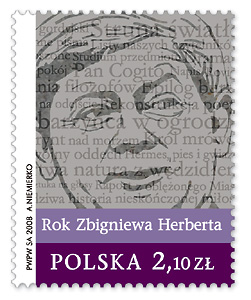 |
author: Anna Niemierko
number of stamps: 1
denomination: PLN 2.10
print run: 500,000
printing technique: offset
stamp size: 31.25 x 39.5 mm
paper: fluorescent
selling sheets: containing 20 stamps
issue date: 1 December 2008
FDC

Dear collectors,
The Year of Zbigniew Herbert
28 July 2008 was the 10th anniversary of the passing away of one of the most outstanding Polish 20th century literary artists -Zbigniew Herbert. This extraordinary poet, essayist and playwright didn't live to receive a Nobel prize, although in the minds of many of the connoisseurs and admirers of his work worldwide he had deserved it more than anybody else. Therefore, by a resolution of the Polish Parliament, the year 2008 has been proclaimed the year of Zbigniew Herbert.
A savage in the garden
Zbigniew Herbert was born in 1924 in Lviv. His rich life story includes numerous dramatic events. After he had completed clandestine classes and passed his final secondary school examinations (pol. matura, equivalent of the Anglo-Saxon A-Level examinations) in Lviv, which was then occupied by the Germans, he studied Polish Philology and later, in Krakow, he took up studies in Economy at the Cracow University of Economics and Law at the Jagiellonian University. At the same time, he begun a course at the Cracow Academy of Fine Arts. If that wasn't enough, he got involved in the underground activities of the AK (pol. Armia Krajowa - Polish armed forces in conspiracy, an underground force in operation during the years of WW II). During the war and occupation he worked as, among others, a flea feeder with an institute developing vaccines against typhus. He completed his studies in Law in 1949 at the Nicolaus Copernicus University in Toruń, after which he took up philosophy. His versatile education later on gave rise to unmatched poetry, forcing the reader to think hard and requiring knowledge of many fields of arts and science. His first literary appearance was in press in 1950, and his first published book, Struna Światła, came out six years later. In the 1980s Herbert was the poet of the Polish resistance. He always used to keep outside the poetic mainstream and only follow his own ways.
Side by side with Mr Cogito
Zbigniew Herbert created the literary person of Mr Cogito as his alter ego. It is this imaginary character that the poet employed to voice truths too painful or difficult to say out loud, and also to talk about regular problems, the real world, and imaginary worlds. He never ceased his exploration of the paths of life, but also walked along country roads, in towns and cities, often wandering beyond the limits of reality. He would constantly keep looking for something which fled him, he never ceased to wonder, always used to contemplate, let himself get surprised. Mr Cogito is a modern man, but he is at the same time strongly attached to the Mediterranean civilisation and its heritage, and therefore full of contradictions, evoking admiration for the truths that he teaches and his attitude towards the world, but at the same time objection against some of the solutions he proposes. Like Mr Cogito, the poet never accepted compromise in real life. When old friends became enemies, he had no sympathy towards such conduct. This is how he voiced it in his poem entitled The Envoy of Mr Cogito:
(...) be courageous when the mind deceives you be courageous
in the final account only this is important (...)
and do not forgive truly it is not in your power
to forgive in the name of those betrayed at dawn (...)
Be faithful Go*
A citizen of the world
Zbigniew Herbert travelled extensively (among others to Austria, France, the USA, the Netherlands, Belgium, Israel). He would always return to his country, but only to leave on a journey again. Seriously ill, he settled down permanently in Poland in 1992. He died on 28 June 1998 in Warsaw. Buried at the Warsaw Powązki cemetery, he was posthumously decorated with the Order of the White Eagle, the last one out of an impressive collection of awards which he received in numerous countries worldwide.
New stamp and First Day Cover
On account of the Year of Zbigniew Herbert, the Polish Post introduced a postage stamp containing an image of the writer on the background of his poems. The FDC contains a facsimile of the manuscript of Herbert's poem called Kamyk, printed on the background depicting a blue and grey rock. The issue is accompanied with an occasional date stamp, in use in Warsaw I Post Office.
Glossary
alter ego - literally: "the other I", a confidant, trustworthy assistant, a friend
cogito - literally: I think; here: Mr Thinking
*see John Carpenter & Bogdana Carpenter translation
The 30th anniversary of the election of Karol Wojtyla as the Pope.
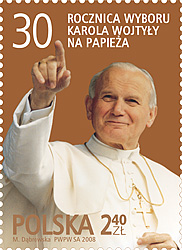 |
author: Marzanna Dąbrowska
number of stamps: 1
denomination: PLN 2.40
print run: 600,000
printing technique: rotogravure
stamp size: 31.25 x 43 mm
paper: fluorescent
selling sheets: containing 6 stamps
issue date: 27 November 2008
FDC

Dear collectors,
The 30th anniversary of the election of Karol Wojtyla as the Pope.
An outstanding pontificate
At the time when 30 years ago, on 16 October 1978, a voice called out from the Vatican window with the words "Habemus Papam", nobody had suspected that a revolution in Vatican City was at hand. For the first time in over 450 years it wasn't an Italian who had been appointed the Pope. The merely 58 years old Karol Wojtyla, as Pope John Paul II, proved to be a great and extraordinary man, whom the entire world looked up to with admiration and respect.
The grounds for the overhaul brought by the Pope-revolutionary were laid by his predecessors, i.e. John XXIII and Paul VI, and also John Paul I who had been the Pope for just 33 days. Following the Second Vatican Council, there arose a need for someone who would temper the disputes within the Church, and John Paul II knew how to talk to anyone, regardless of their position, nationality, age, or faith. Owing to those skills, he managed to bring about the ecumenical prayer meetings in Assisi and to be the first Pope ever to visit a synagogue or a parliament. He attracted millions of young people to, among others, the celebrations of the World Youth Day. For a great number of them, the pontificate of John Paul II is their whole life, and it needs to be remembered that it was the third longest in history, following the pontificates of st. Peter (37 years) and Pius IX (more than 31 years).
The Pope - a pilgrim, and a missionary, made over 104 journeys to 129 countries. Wherever he went, he won the hearts of people with his neutrality, his openness, his smile and his direct approach. He never avoided meeting the crowds who gathered there for him, and people invariably flocked around Him. Just like a good father, he was able to evoke respect, for His mission was to preach the Gospel and to show the right way in the modern world. He affected human souls, as he did the world's history. Everybody agrees that by raising the spirits of his compatriots during the PRL period, he actually contributed to the downfall of communism.
The Pope - a follower of Jesus Christ, had borne his cross for many years. His life was very harsh from the early childhood. He lost his mother early, and then his brother, and eventually his father, who had been a model of discipline and piety for him, as well. Instead of becoming an actor, he chose the difficult ways of priesthood. He never spared himself. He was fit and enjoyed skiing and trekking in the mountains, but his strength and health withered in the course of his service, beginning with his attempted assassination on 13 May 1981. Although he suffered from a severe disease, he made an effort to keep fulfilling his duties to the end. He never tried to hide his pain, which gave people yet another lesson of faith. When this greatest moral authority of the 20th century passed away, the people gathered on st. Peter's square spontaneously called out "Santo Subito", thus summing up his life's mission.
New postage stamp and First Day Cover
To commemorate the 30th anniversary of the election of Karol Wojtyla as the Pope, the Polish Post issued a unique postage stamp whose design highlights one of the major qualities of John Paul II - his sense of humour. This stamp, with its joking graphics, presents the Pope as we got to know him during his many pilgrimages. The golden background does not enclose the Pope within the boundaries of his rank, but again shows the overcoming of stereotypes.
The First Day Cover, apart from the image of st. Peter's Chapel in Rome, presents 3 dates which stand for the announcement of the conclave's decision in 1978, the death of the Pope, and the 30th anniversary of his election. The issue is accompanied by an occasional date stamp, used in the Krakow 1 Post Office. Another version of the date stamp, called Rome 1, has also been prepared, as the official launch of the new stamp will be held in the Polish Embassy in Vatican.
Philately
The Polish Post has commemorated all significant events related to the person of Pope John Paul II. Among numerous postage stamps there were 3 series issued in cooperation with the Vatican Post Office, including a stamp printed on silver foil, released on the 25th anniversary of his pontificate. All the issues are presented on:
www.kzp.pl/index.php?artykul=kat-zt-papiez
Christmas
 |
 |
author: Jerzy Pietras
number of stamps: 2
denomination: PLN 1.45, PLN 3
print run: PLN 1.45 - 28,000,000
PLN 3 - 2,700,000
printing technique: rotogravure
stamp size: 31.25 x 39 mm
paper: fluorescent
selling sheets: containing 50 stamps
issue date: 27 November 2008
FDC
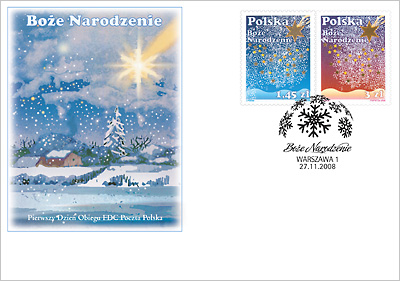
Dear collectors,
Christmas
New stamps and First Day Cover
As every year before Christmas, also this time the Polish Post has prepared new postage stamps for domestic and foreign correspondence for all those who would like to say the traditional "Merry Christmas and a Happy New Year" by means of pen and paper. The dominating element of the graphic design of the stamps and the FDC is the Star of Bethlehem placed on the background of a winter landscape, with snowflakes glimmering in the starry sky. The issue is accompanied with an occasional date stamp, in use in the Warsaw I Post Office.
The Star of Bethlehem
Known to everyone, the star which is thought to have guided the three Magi on their way to find the newborn Messiah was not, as artists have for centuries depicted, a flaming comet. Such a spectacular phenomenon would surely be visible to everybody, not just wise men, and a comet sighting was commonly taken as a sign of a coming disaster, rather than glorious news. So what could the Star of Bethlehem have been? Many scientists have long puzzled over this question. Eastern scholars seem to point to astrologers, since it is that region where the knowledge comes from and they were the only ones who knew how to read and decipher the mysterious signs in the sky, but what was the star exactly? Unfortunately, astrology is an obscure art, and it accounts for celestial phenomena in ambiguous ways. Perhaps Kepler was right to claim it was merely a conjunction (close encounter) of Saturn and Jupiter, and maybe it was the ones who think it was Venus, rather than Saturn, that were closer to discovering the truth - who knows? Whatever the case might be, it has for centuries been our unshakable tradition to look for it in the first star that shines after dusk, for it is not the celestial body that is important, but the event it heralds.
Year of Independence
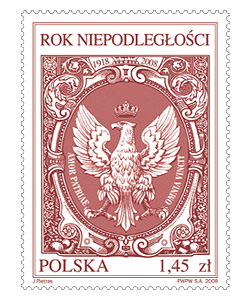 |
author: Jerzy Pietras
author of engraving: Maciej Kopecki
number of stamps: 1
denomination: PLN 1.45
print run: 400,000
printing technique: steel engraving
stamp size: 40.5 x 54 mm
paper: fluorescent
selling sheets: containing 35 stamps
issue date: 11 November 2008
FDC

Dear collectors,
Year of Independence
National Independence Day
In 2008 Poland shall celebrate the 90th anniversary of the regaining of independence. On 11 November main events, with the participation of state authorities and the Polish army, will take place on the Józef Piłsudski Place in Warsaw, in front of the Unknown Soldier Grave,.
During the Midwar Period the Independence Day was officially celebrated only in 1937 and 1938. During the German occupation any celebration of the Independence Day was forbidden. It was similar after the II World War. From 1945 the most important state holiday, replacing the November feast, was the Rebirth of Poland, celebrated every 22 July (on that day the Manifesto of the Polish Committee of National Liberation (PKWN) was signed). Although the opposition activists laid flowers on 11 November at the Unknown Soldier Grave, sang patriotic songs, arranged services to the Fatherland and organised marches, any such public manifestation of any patriotic behaviour on that day was suppressed by Militia and ZOMO (Motorised Reserves of the Citizen's Militia). The National Independence Day was reinstated under the Law only on 21 February 1989.
A bit of history
On 11 November in Compiegne, France, truce ending the I World War was signed. On that same day, in Poland, the Regency Council appointed Józef Piłsudski the Commander in Chief of the Polish state and entrusted him with the entire civil and military power; afterwards the Council was dissolved. The whole country was in euphoria because of the independence it regained. After 123 years of slavery, in which many Poles lost their lives, were killed by invaders during many independence appraisals, died of hunger in Galicia, died because of Prussian displacements, Russian deportation to Siberia, imprisonment and tortures, for any signs of the Polishness and any protest - the Poles had finally had their free Fatherland which the generations of Poles dreamt of. II Republic of Poland survived for only 20 years, however, during that time the Poles were very busy. What was to be done was the new Polish statehood: efficiently acting administration, new legislation, schools and universities, jurisdiction, press; quick economic development was to be taken care of. Patriotic enthusiasm and sacrifice determined the citizens to work for the benefit of their beloved Fatherland. Youth had its significant stake in it. It is worth remembering now too.
The most important dates:
6/7 XI 1918 - in Lublin, the Provisional People's Government of the Republic of Poland was established and Ignacy Daszyński was appointed its Prime Minister and Minister of Foreign Affairs
10 XI 1918 -Józef Piłsudski returned to Warsaw from internment in Magdeburg
11 XI 1918 - in Compiegne, France, truce of all war participants was signed (Germany surrendered), which ended I World War
16 XI 1918 - Józef Piłsudski announced creation of the independent Polish state
19 XI 1918 - Germany withdrew its forces from the Kingdom of Poland
22 XI 1918 - decree on the principles of the Polish state system was signed
New stamp and first day cover envelope (FDC)
The Sejm of the Republic of Poland, with due honour bid to all who fought for the free and just Fatherland, adopted a resolution (of 7 February 2008) establishing this year the Year of Independence. To celebrate this exceptional for Poles anniversary the Polish Post has marketed a postage stamp with an emblem of the White Eagle with a crown from the time after the assumption of independence, with a Latin inscription around it saying: AMOR PATRIAE OMNIA VINCIT ("Love of Country Conquers Everything"). The FDC envelope depicts three soldiers of the Polish army formations: legionnaire (Józef Piłsudski was the creator and chief of I Brigade of the Polish Legions), hallerczyk (a soldier of the Polish Army in France, called Haller's Army by the name of the chief of that army Józef Haller) and the soldier of the Polish Army - the army created after the regaining of independence. The first two formations were included in that army. The stamp is accompanied by an occasional date stamp used in Warsaw I Post Office.
Philately
For the first time a stamp to commemorate the regaining of independence was issued in 1933. In 1938 the 20th anniversary was celebrated by the issue of a block of four stamps with portraits of leaders of II Republic of Poland and a series of thirteen stamps presenting historical events important for the country. Other anniversary issues appeared only after 50 years, in 1988, 1993 and 1998.
100th anniversary of Rota (the Oath) byMaria Konopnicka
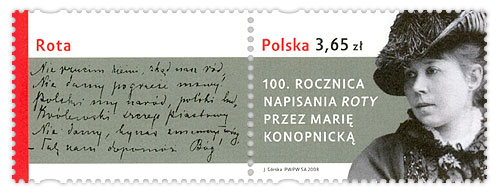 |
author: Joanna Górska
number of stamps: 1
denomination: PLN 3.65
print run: 400,000
printing technique: offset
stamp size: 43 x 31.25 mm
paper: fluorescent
selling sheets: containing 10 stamps and 10 se-tenant labels
issue date: 7 November 2008
FDC

Dear collectors,
100th anniversary of Rota (the Oath) byMaria Konopnicka
It has been 100 years this year (2008) since Rota - one of the most important for the Poles and very much at their hearts patriotic song by Maria Konopnicka was written. The poet's intention was quite different from what it later became; the poem had a life at is own. Rota's first edition was in 1908 in Krakow's paper "Przodownica". Two years later it was issued in "Gwiazdka Cieszyńska" and "Gazeta Polska" in Chicago. In partitioned Poland Rota was for some time the Polish anthem and in free Poland - it served as an anthem of the Polish Scouting movement. Nowadays it is still an unofficial anthem of some peasants' organizations. Rota had its may versions in the country and abroad. It is a second most important national song - after Dąbrowski's Mazurka - to be sung while standing like in the case of the Polish anthem.
Maria Konopnicka - protector of the oppressed
Born in Suwałki under Russian rule, Maria Konopnicka (1842-1910) was in 1908 a famous and appreciated poet not only in the country but also abroad. She was always protecting the weakest, the poorest, the most oppressed and humiliated and those whose fate it was to live in exile. She is an author of such famous poems as: W piwnicznej izbie, Jaś nie doczekał, A jak poszedł król na wojnę, series Wieczorne pieśni, Z łąk i pól,epic Pan Balcer w Brazylii and works for children, among others, novel O krasnoludkach i sierotce Marysi. Rota, consisting of four stanzas was written in order to protect the Polish peasants obligatorily displaced by the Prussians within the German deportation of the Poles in Wielkopolska (i.e. rugi pruskie). Rota was so universal that the decision was taken to use it to commemorate the 500th anniversary of the Battle of Grunewald.
Feliks Nowowiejski - more than average
Born in Wartembork (today Barczewo), in Warmia region, under Prussian rule, Feliks Nowowiejski (1877-1946) was a young performing musician, composer and conductor, prize-winner of prestigious foreign prizes, author of, among others, famous oratorios as Znalezienie Św. Krzyża and Quo Vadis. He composed this noble and beautiful melody for Rota's lyrics in 1910 two years after the poem's first edition. The first performance of Rota was on 15 July 1910 in Krakow, during the unveiling of the Grunewald Monument founded by Ignacy Jan Paderewski to commemorate 500th anniversary of the victory at the Battle of Grunewald. This wonderful and thrilling song was sung then by many choirs from the entire country which were conducted by the composer himself. The news of the day was that the performance made the audience cry of thrill.
Two hearts, two inspirations
The song is the "meeting" of two Polish hearts and two inspirations with an outcome of a small in form but huge in contents artwork. This poem and music is not only alive nowadays; it is evoking such emotions and feelings as in the past: dignity, outburst of emotions and national pride. Very frequently does it happen that lyrics and words of the work are so ravishing and at the same time beautiful as in Rota.
New postage stamp and First Day Cover FDC
To celebrate the 100th anniversary of Rota, the Polish Post issued a postage stamp with the poet's photo. The stamp has a tag with a facsimile of Rota's first stanza. FDC envelope depicts a facsimile of the song's music on which one can see composer's notes. Apart from the work's number (op. 38 no. 2) there is an inscription there: "Composed for the Grunewald anniversary in 1910 in Krakow". The composer marked also the song's interpretation: "march, with eagerness". The stamp is complemented with an occasional date stamp, in use in the Warsaw I Post Office.
The 50th anniversary of the "Kabaret Starszych Panów" comedy series.
 |
author: Agnieszka Sobczyńska
number of stamps: 1
denomination: PLN 1.45
print run: 450,000
printing technique: offset
stamp size: 31.25 x 43 mm
paper: fluorescent
selling sheets: containing 16 stamps
issue date: 30 October 2008
FDC

Dear collectors,
The 50th anniversary of the "Kabaret Starszych Panów" comedy series
Two Aging Gentlemen!
Although the Kabaret Starszych Panów comedy show was established at a time when television wasn't common in Polish homes, the unique nature of the series certainly made it an unforgettable one and though some of the recorded material was lost irretrievably, we still have all the reason to celebrate the 50th anniversary of the creation of this outstanding work of musical and literary wit. Its founders: Jeremi Przybora (1915 - 2004) and Jerzy Wasowski (1913 - 1984) met in 1939 in a radio studio, where Przybora worked as a presenter and Wasowski was responsible for sound engineering. After the war they joined forces and started the "Eterek" radio theatre (1948-1958). Przybora was primarily a poet, a writer of song lyrics and a radio director. On the other hand, although Jerzy Wasowski originally wanted to become a physicist, he turned out to be an outstanding composer. He wrote music with great ease even though he didn't really treat it as a serious occupation. Both artists shared a unique sense of humour and a great talent for acting. When in 1958 Jeremi Przybora was forced to comply with an agreement he had with the television, he wrote the first episode of the Kabaret Starszych Panów comedy show. Merely 16 episodes were made by 1966. Although in the beginnings of the project the "ageing gentlemen" - Gentleman A and Gentleman B - were both just a little over forty, their opening song went "Though our hair is turning grey, and our health is withering away - we are still young at heart!" The gentlemen used to appear on stage in smart evening clothes, which didn't match the Polish reality of the communist regime. The plot of each of the episodes was intertwined with songs, whose lyrics used to be perverse, absurd, and charmingly frivolous (e.g. "Kapturek '62", "Bo we mnie jest seks", "Tango >Kat<", "Już kąpiesz się nie dla mnie", "Ballada z trupem", "Odrobina mężczyzny"), but sometimes also lyrical, like for instance "SOS", written for Ms. Kalina Jędrusik, and "O, Romeo!" And of course, who doesn't recognise such titles as "Wesołe jest życie staruszka", "Kaziu, zakochaj się", "Rodzina", "Upiorny twist", "Addio, pomidory!" or "Piosenka jest dobra na wszystko?"
An array of best Polish actors, whom the creators knew from the theatre and radio, appeared from time to time on this unique show. Laborious efforts produced outstanding and expressive performances, and the songs were difficult to play (e.g. canons) and, in particular, difficult to sing due to Przybora's reckless wording of the lyrics, such as in the famous duets "Przeklnij mnie", "Tanie dranie", "Jeżeli kochać" ("wespół w zespół, by żądz moc móc zmóc!"). The songs used to be recorded in advance, but the show, which was aired live, required a great deal of coordination between the actor and the lyrics, so some of the songs needed a lot of training to avoid mistakes when singing things, like "Tatka tka i matka tka,/a praczka czka i, czkając, tka" czy "Ząb zupa dąb zupa ząb".
As Wojciech Młynarski once said, Kabaret Starszych Panów was "a wonder of mass culture of the 1960s; an exclusive, elevated programme requiring sophistication and using a pastiche of styles and genres, but at the same time reaching not only the intellectuals, but simply everyone."
New stamp and First Day Cover
The stamp and the cover issued to commemorate the anniversary of the Kabaret Starszych Panów cabaret are designed in the same style as the setting of the show - the studio decorations were not precise, but rather implied, simplified, outlined with a single straight line. The stamp presents the creators, Jeremi Przybora and Jerzy Wasowski, and the FDC contains images of the head performers: Barbara Krafftówna, Irena Kwiatkowska, Wiesław Michnikowski, Mieczysław Czechowicz, Wiesław Gołas, Edward Dziewoński, and Kalina Jędrusik. The issue is accompanied with an occasional date stamp containing the symbols of the Ageing Gentlemen, that is their top hats and walking sticks, in use in the Warsaw 1 Post Office.
EU Capital Cities
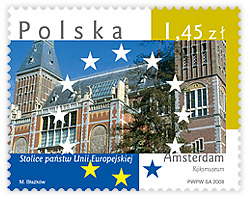 |
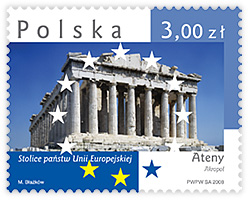 |
 |
 |
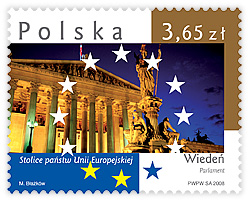 |
|
author: Magdalena Błażków
number of stamps: 5
denomination: 2 x PLN 1.45, 2 x PLN 3, 1 x PLN 3.65
print run: 500,000 each
printing technique: offset
stamp size: 39.5 x 31.25 mm
paper: fluorescent
selling sheets: containing 20 stamps
issue date: 24 October 2008
FDC
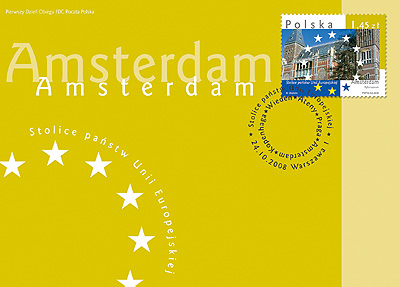
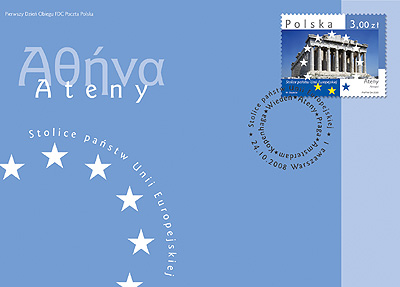
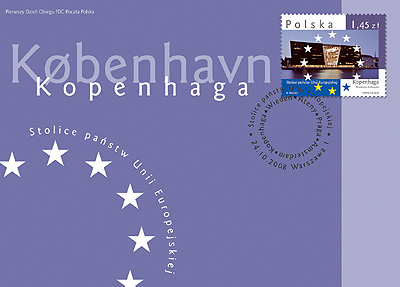
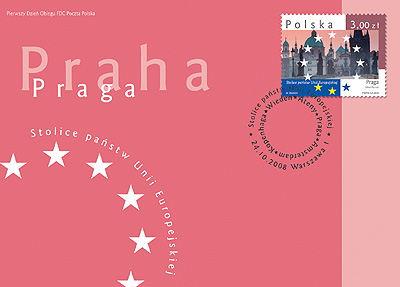
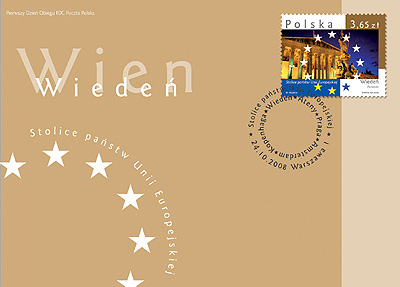
Dear collectors,
EU Capital Cities
New stamps and first day cover envelopes FDC
This year the Polish Post has prepared a fourth edition of the "EU Capital Cities" series issued since 2005. The stamps are accompanied by five first day envelopes FDC and one anniversary date stamp, used in Warsaw 1 Postal Office.By now we have seen representative buildings of Budapest, Berlin, Dublin, Lisbon, London, Ljubljana, Luxembourg, Madrid, Paris, Riga, Rome, Stockholm, Tallinn, Valetta and Vilnius.
Amsterdam - Rijksmuseum
The Netherlands' capital city is a harbour town founded in the 13th century. Its name means a dam on the Amstel river. The most extensive development of the town (as well as the whole Holland) was in the 17th century during the so called Golden Age i.e. when a network of canals creating the unique atmosphere of Amsterdam was dug.
The building depicted on the postage stamp is the famous Dutch national museum - Rijksmuseum, built at the end of the 19th century in a mix of Gothic and Renaissance styles. It exhibits rich collections of art of the 15th - 19th century and the greatest collection of Dutch paintings of the 17th century. The museum is especially proud of its collection of the Rembrandt masterpieces with the famous "Night Watch" of 1642 among the best ones.
Athens - the Acropolis
The origin of Athens was the Mykines fortress of the 13th century BC erected on a limestone hill, further called Acropolis (Greek: akropolis - upper city). Later a city-state (polis) developed around Acropolis which transformed into a religious centre. After being destroyed by the Persians in the 5th century BC, Athens was reborn magnificently under the rule of Pericles. As a result of conquests, under the rule of Macedonia, Rome, and since the 15th century - Turkey, the city had fallen into decay. It became the capital city of the new Greece only in 1834. The Acropolis of Athens is today a popular destination for tourists and a symbol of the Ancient Greek civilization.
The Parthenon depicted on the stamp was built in 447-432 BC, in honour of Athena Parthenos, patron of the city. Phidias, the most distinguished architect of the Ancient Greece was the designer of decorative elements of this Doric temple. Inside there was a gold and ivory huge Athena's statue presumably also sculpted by Phidias.
Copenhagen - the Royal Library
A fishing village Havn (Harbour) by the Oresund strait, founded at the beginning of the 11th century developed thanks to a castle built nearby and already in the 15th century it became the Danish capital - Kobenhavn (Harbour of Merchants), important commercial centre for the northern Europe.
The stamp presents a photo of the newest part of the Royal Library - one of the biggest in Europe. It contains, among others, manuscripts of Karen Blixen, Hans Christian Andersen and Soren Kierkegaard. A new building called the Black Diamond (because of a black granite and dark glass used for its construction) was open for the public in 1999.
Prague - the Charles Bridge
Famous for the beautiful architecture Czech capital was established upon the joining of two cities of the early Middle Ages: Hradčany and Vyšehrad. The representative for ages seat of the Czech rulers was handed over in the 16th century to the house of Habsburg, and at the same time to be dominated by Vienna. Only the so called Czech National Revival in the 19th century restored the city's previous character. Prague was again the capital city in 1918 upon the creation of Czechoslovakia. In 1993 after the split of Czechoslovakia, the city became the capital city of the Czech Republic.
The Charles Bridge (by 2nd half of the 19 century called the Stone Bridge or the Prague Bridge) connects two districts: Malá Strana and Staré Mesto. It is 515 meters long and approximately 9.5 meters wide. It was built in the 14th century (replaced the 12th century Judith Bridge destroyed by flood), by 1741 was the only bridge on the Vltava river. Its Gothic character has been emphasised by the towers protecting the bridge. The famous 30 statues of saints were added only in the times of baroque.
Vienna - the Parliament
Founded around 500 BC Vienna was originally a Celtic settlement, and later a Roman Vindobona. It constituted a northern edge of the Empire. In the Middle Ages Vienna was a capital city of the Habsburg dynasties. In the 16th and 17th century the city stopped attacks of the Ottoman armies. In the 18th century Vienna flourished and transformed into a cultural capital of Europe. A new European era was created here during the Congress of Vienna. Vienna has been the capital city of Austria since 1918.
The building of the Parliament presented on the postage stamp is a place where both houses of the Austrian Federal Assembly have their sessions. It was created in 1874-1883 based on the design of a Danish architect Theophil von Hansen. The Pallas Athena fountain highlights its Neo-classical character.
Great Polish composers of the 20th century
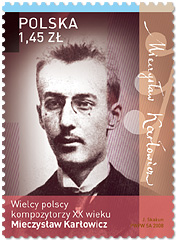 |
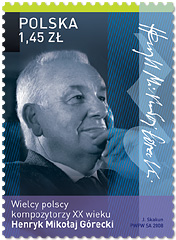 |
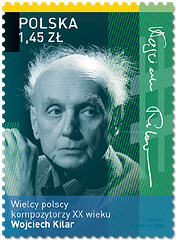 |
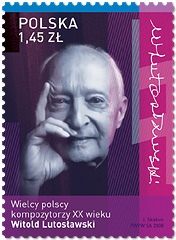 |
author: Jerzy Skakun
number of stamps: 4
denomination: 4 x PLN 1.45
print run: 500,000 each
printing technique: offset
stamp size: 31.25 x 43 mm
paper: fluorescent
selling sheets: containing 20 stamps
issue date: 18 October 2008
FDC

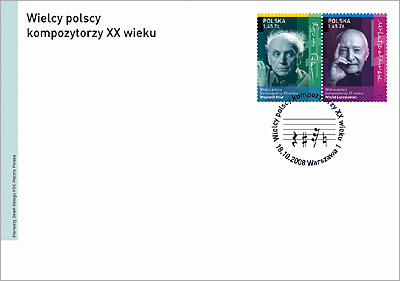
Dear collectors,
Great Polish composers of the 20th century.
Contemporary music
The 20th century was a time of significant change not only in science and technology, but also arts, including music. For composers it represented an age of intense searching, experimenting, discovering new composing techniques and creating innovative sound systems (e.g. dodecaphonics). Among others, mathematics and chance (such as is applied in the so-called aleatoric music) were the composer's tools of work and the range of available sounds was broadened through unconventional use of musical instruments (e.g. sonorosm), the employment of recorded background sounds (concrete music) or the introduction of electronic music. Musical notation also evolved, resulting in an abandonment of the traditional use of notes. The 20th century music is an enormous versatility of directions, rich in outstanding personalities such as the Polish composers presented on the postage stamps:
Mieczysław Karłowicz (1876-1909) - born in the area of Vilnius, he received training in the violin, the grand piano, and the concertina in Warsaw, and studied composing in Berlin. His style was characterised by nostalgia, and even sadness, contradicting his rich instrumentation, typical of the last decade of the 19th century Polish arts. At first he used to compose songs, which he later abandoned completely for the sake of orchestral works. He took part in the works of the Warsaw Music Society board in an attempt to promote Polish contemporary music in the repertoire of the philharmonic. In 1907 he settled in the city of Zakopane. A solitary person that he was, mountains were his passion, and he photographed them during his many journeys. Sadly, he never returned from one of them, buried by an avalanche.
Witold Lutosławski (1913-1994) - an alumnus of the Warsaw Conservatoire. Apart from training in the grand piano and the violin as well as in the art of composing, he also studied mathematics. During the war he earned a living playing for the entertainment of cafe guests together with A. Panufnik. A versatile artist, he ventured beyond classical music and composed works for the radio, the theatre, and even songs, including those for children (e.g. for the writings of J. Tuwim). His innovative style is characterised by creativity, but at the same time by precision. He experimented with numerous different methods such as aleatorism, and conducted the performance of his own works on many occasions. He was presented with numerous national and international awards.
Wojciech Kilar (born in 1932 in Lviv) - having finished his studies in Katowice, he had an opportunity to go on a scholarship to Paris, where he was trained under the guidance of Nadia Boulanger. In the 1950s and the 1960s, he wrote avant-garde music, but since the 1970s he has begun seeking inspiration in religious and folk traditions. His expressive works are still known to a wide audience today, mostly owing to more than 100 compositions for films such as "Ziemia obiecana" (1974), "Drakula" (1992), "Pan Tadeusz" (1999), "Pianista" (2001).
Henryk Mikołaj Górecki (born in 1933) - a student, and subsequently tutor, at the Katowice Music Academy (PWSM Katowice). At first he used to employ novel composition techniques, mostly sonorism. His works appear simplified due to the use of repetitions, series, and symmetrical structures. Gradually, the composer begun to make use of tradition, and introduce citations and stylisation. An album published in 1992, containing his 3rd Symphony which had been composed 16 years before, was an international success and went to the very top of the charts.
New stamps and first day covers
The Polish Post presents four new postage stamps containing portraits of the Polish contemporary composers, whose work represents a model for the next generations to follow. Apart from photographic portraits, the stamps also contain the artists' handwritten signatures. The stamps and FDC covers are accompanied by an occasional date stamp, in use in the Warsaw I Post Office.
World Post Day
 |
author: Maciej Jędrysik
number of stamps: 1
denomination: PLN 2.10
print run: 400,000 each
printing technique: offset
stamp size: 43 x 31.25 mm
paper: fluorescent
selling sheets: containing 20 stamps
issue date: 9 October 2008
FDC

Dear collectors,
A Celebration of the Post
On 9 October, the anniversary of the establishment of the Universal Postal Union, the postal services worldwide are celebrating their holiday. The World Post Day, celebrated every year since 1969, is a perfect opportunity to talk about the long history of the local postal operators, and to promote international cooperation between them under the auspices of the UPU. This year the Polish Post has all the more reason to celebrate due to its 450th anniversary, which falls on 18 October.
New postage stamp and First Day Cover
On account of the World Post Day this year, the Polish Post has prepared a stamp presenting a drawing of a carrier pigeon dressed in a postman's hat. The design of the first day cover illustrates the global nature of the holiday. The issue is accompanied by an occasional date stamp, in use in the Warsaw I Post Office.
Carrier pigeons
The ancestor of the carrier pigeon, as well as other domestic pigeons (Columba livia domestica), is the rock pigeon. In breeding, it is particularly its unique natural ability to find its way back to the loft from very large distances that is being developed. It means that in order to deliver a message, the pigeon must first be transported. The message needs to be extremely light, preferably written on very thin paper, then rolled up and placed in a small tube attached to the bird's foot.
The pigeons are extraordinarily fast and resilient. They travel at average speeds of 50-70 kilometres per hour, and record distances covered by these animals are as long as 1,800-2,000 kilometres! It isn't exactly clear how the pigeons find their way back. It's probable that they rely on their ability to feel the earth's magnetic field and their sense of smell, and it's only when they get very close to their goal that they actually start using their eyesight to navigate.
Pigeons have been used at least since the 12th century, particularly during wars, in order to deliver news of victory or defeat. The so-called "pigeongrams" were also transmitted during the French-Prussian war of 1870 and World War I (among others in the Boyen stronghold). Some of the pigeons were even decorated for their service when they delivered messages despite having suffered injuries. In mid 19th century Paul Reuter (the founder of the Reuters news agency) used to employ carrier pigeons to send information about the stock exchange prices between Brussels and Aachen before a telegraph was installed. Between 1896 and 1908 a regular postal service based on carrier pigeons operated in New Zealand, transporting messages between the city of Auckland and the Great Barrier Island, using the very first "airmail" stamps.
In Poland, carrier pigeons have been bred since the beginning of the 20th century. Breeding pigeons required a permission from the Ministry of Military Affairs (pol. Ministerstwo Spraw Wojskowych), as the pigeons were a strategic communication medium. That was why the German invaders ordered the removal of all the pigeon lofts on the territories they controlled. At present, breeding carrier pigeons is a hobby as well as a sport - the birds take part in competitions.
Although the pigeon postal service was never broadly used, it constitutes a very popular symbol of the post, and as such it is often represented on postage stamps.
100th anniversary of the foundation of the Łódź Sports Club (ŁKS)
author: Marzanna Dąbrowska
number of stamps: 1
denomination: PLN 1.45
print run: 500,000
printing technique: rotogravure
stamp size: 39.5 x 31.25 mm
paper: fluorescent
selling sheets: containing 50 stamps
issue date: 30 September 2008
FDC

Dear collectors,
100th anniversary of the foundation of the Łódź Sports Club (ŁKS)
First steps
ŁKS has been the biggest and oldest sports club in Łódź, founded in 1908 upon the initiative of young football fans who used to meet on the ground near factories and created a team called "Łodzianka". Łódź was at that time annexed by Russia and only German and Russian sports club of very old-fashioned structures could be found there. Young Poles returning from studies abroad were aware of high levels of sport education in the Western Europe. Decision was then taken that Łódź should found its own club. At first, the governor of Piotrków refused to register the club and pointed at some national elements in the club's statutes. Another attempt was successful only after revising the statutes' contents with the help of a governor's official.
During the I Word War the club suspended its activity, however in the Interwar Period ŁKS was very successful and in 1927-1938 it was playing in the I league.
Not only football
Since the very beginning, football has been the main sport in ŁKS, though within 100 years also new sections were offered: basketball (high-level, very successful, also in the 70's and 80's), volleyball (in the 80's successful in the Championships of Poland), hokey (not anymore) and youth and amateurs sections (athletics, tennis, contest, weight-lifting, rugby and boxing). ŁKS is the place where many Polish sportspersons started their career.
The biggest success and the best sportsmen
ŁKS fans still remember the biggest football success in 1954 - a Vice-Championship of Poland, Cap of Poland in 1957 and Championships of Poland in 1958 and 1998. It wouldn't be possible if it was not for such great sportsmen as, among others: Władysław Soporek, "king" of shooters of 1958; national team football players: Henryk Szczepański, Stanisław Terlecki, Marek Dziuba, who played in the World Championships in 1982 when Poland was 3rd, coach and trainer; Jan Tomaszewski, one of the best goalkeepers in the Polish football history, coach and journalist; Tomasz Wieszczycki who participated in the Olympics in Barcelona in 1992.
ŁKS may be proud of its great athletes: Maria Kwaśniewska-Maleszewska, Olympics brown medal in 1936 for spear-throwing; Teresa Ciepły, runner, awarded three times during the Olympics and European Championships; Artur Partyka, high-jumper, awarded many medals in the Olympics, World Championships and European Championships.
New postage stamp and First Day Cover
ŁKS has been the first sports club ever honored by the Polish Post by the issue of the postage stamp. The stamp depicts in club's color main sports disciplines that were or still are offered by ŁKS: football, hokey, basketball, tennis and volleyball. FDC envelope shows an archival photo of a football player Henryk Szymborski (1931-2008) rejoicing the goal. Szymborski played in ŁKS in 1950-1952 and 1955-1963. Szymborski was a forward and was famous for efficient shooting. Six times was he in the national team. Henryk Szymborski died on 30th August 2008.
An occasional date stamp will be used in the Post Office Łódź 1.
400th anniversary of the Poles' arrival in America
author: Agnieszka Sobczyńska
number of stamps: 1
denomination: PLN 3
print run: 600,000
printing technique: offset
stamp size: 43 x 31.25 mm
paper: fluorescent
selling sheets: containing 6 stamps
issue date: 30 September 2008
FDC

Dear collectors,
400th anniversary of the Poles' arrival in America
The first Poles in America
The year 1620 is generally established as the foundation date of the first American colony, when the so called "founding fathers" stepped off their ship, the Mayflower, and started the Plymouth settlement. However attempts to settle the land had been made as early as 20 years before that. It isn't common knowledge, though, that some of the earliest settles in America were Poles!
In 1607 the British Virginia Company established the Jamestown colony, which served as a trade centre. It needed qualified workforce, who were recruited not only England. Among the new settlers to reach Jamestown on 1 October 1608 on board "Mary and Margaret" there were such new settlers. The group included Dutchmen, Germans, and also Poles (probably five). Their work included manufacturing tar, potash, wood tar, lye and glass. They were also employed in carpentry.
The Jamestown settlement was administered by captain John Smith, whose exciting adventures have survived in stories such as that of Pocahontas. It is likely that he had come in contact with the Polish people many years ago, e.g. when battling Turks in Transylvania. The surviving records and testimonies of captain Smith imply that the Poles were outstanding craftsmen, renown for their commitment.
Apart from manufacturing the first export goods, the Poles were responsible for the first industrial action in the history of America. When in 1619 Jamestown announced its first local election, foreigners were left out. As a sign of protest, the Poles abandoned their workstations, which convinced the London central to accede to their demands - the Poles received rights equal to the ones held by the other settlers. Additionally, they were instructed to train journeymen in order to pass on their priceless skills.
Within the following decades the colony was devastated as a result of war with Indians and very harsh living conditions. Many of the settlers died, while others moved away in search of more peaceful places to live.
New postage stamp and First Day Cover.
The Polish Post presents an anniversary postage stamp issued to commemorate the 400 years of Polish settlement in America. An Indian profile, accompanied by a drawing symbolising a Polish settler from 1608, are placed against a background containing an outline of both continents. Sets of six stamps are printed on decorative sheets. The First Day Cover presents a map of America and an outline of a sailing ship. The same decorative motive is present in an occasional date stamp, used in Warsaw I Postal Office.
Philately
In October 1958 the 350th anniversary of the arrival of the first Poles to America was celebrated. The Congress of the Polish Community in the United States (Polonia) received regards from US president Dwight D. Eisenhower. To commemorate that event, the Polish Post had issued two anniversary postage stamps, one of which contained a picture of "Mary and Margaret", and the other - a group of Polish settlers.
Presidents of the Republic of Poland in Exile
 |
 |
 |
 |
 |
 |
author: Agnieszka Sobczyńska
number of stamps: 6
denomination: 6 x PLN 1.45
print run: 600,000 each
printing technique: offset
stamp size: 43 x 31.25 mm
paper: fluorescent
selling sheets: containing 6 stamps
issue date: 24 September 2008
FDC

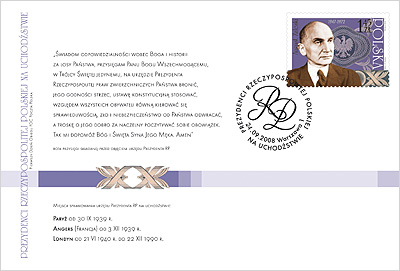


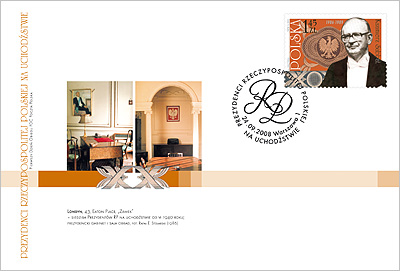
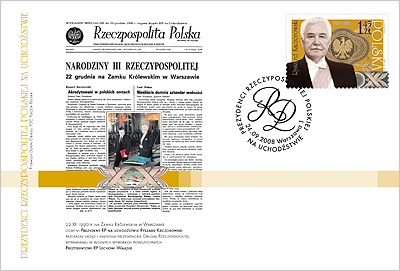
Dear collectors,
Presidents of the Republic of Poland in Exile
The Polish Government in Exile
In September 1939, when Germany and the Soviet Union invaded Poland, the Polish government, led by president Ignacy Mościcki, went into exile. The initial plan to reach France failed, as allied countries did not respect agreements established years before during world peace. The new government was chosen from amongst those politicians who were lucky enough to have entered France. In order to maintain the constitutional continuity of the highest authority in Poland, a new president and the National Council were appointed in place of the dissolved parliament. One of the most pressing matters for the government in exile was the creation of the Polish Armed Forces in the West and establishment the Polish Underground State.
When France capitulated in 1940, the Polish government accepted the hospitality of London. The building at Eaton Place 43, dubbed "The Castle", served as their office until 1990. After the war had ended, the Polish government in exile was no longer acknowledged by the authorities of most countries, but it was not until the eighties when the sessions of the Round Table, the fall of communism (1989) and the free elections finally concluded the efforts of the Government in Exile of the II Republic of Poland. A symbolic act, which concluded the termination of the government in exile was the transfer of the presidential insignia by president Ryszard Kaczorowski to president Lech Wałęsa, who was elected in the general elections of December 22, 1990.
New stamps and First Day Cover envelope (FDC)
The Polish Post is issuing a series of six stamps with images of the presidents of the Republic of Poland in Exile. The graphic design has been fashioned to resemble official national acts and banknotes.
Printed on the stamps are portraits of presidents in office in the years:
- 1939-1947: Władysław Raczkiewicz (1885-1947), lawyer, creator of the Polish armed forces in Russia, minister of the interior, senator and voivode.
- 1947-1972: August Zaleski (1883-1947), historian, outstanding diplomat, foreign minister and senator of the II Republic of Poland. After seven years in office he refused to step down - this decision was one of the reasons of the division among the emigrants. The Council of Three, active between 1954 and 1972, was in opposition to the president.
- 1972-1979: Stanisław Ostrowski (1892-1982), doctor, serviceman, MP since 1930, president of Lwów shortly before the outbreak of the war, prisoner in labour camps, later a soldier of the Polish Armed Forces under the command of General Anders. After the war he resumed his medical practice in Great Britain.
-1979-1986: Edward Raczyński (1891-1993), diplomat (in outposts in Copenhagen and London; ambassador of the Republic of Poland in Great Britain between 1934 and 1945 ), Polish deputy of the League of Nations. Member of the Council of Three (1954-1972).
- 1986-1989: Kazimierz Sabbat (1913-1989), lawyer, soldier of the Polish Armed Forces in the West during the war, actively engaged in scouting.
-1989-1990: Ryszard Kaczorowski (born in 1919), economist, scout, soldier of the Grey Ranks (Szare Szeregi), a prisoner of war in the Soviet Union (1940-1942), after the declaration of amnesty, a soldier in the 3rd Carpathian Rifle Division under General Anders.
Printed on the FDC envelopes are: a record of the oath taken by the first president of the Republic of Poland in Exile, written in Paris on September 30, 1939; the wording of the presidential oath along with the names of the cities which housed the offices of the government of the Republic of Poland in Exile; a poem dedicated to president Ostrowski and the Order of the White Eagle (Order Orła Białego) presented ex officio to all of the presidents of the Republic of Poland in Exile; a poem heralding changes in the motherland, dedicated to president Raczyński, the presidential seal; photographs of the president's office in London; the title page of a special edition of the emigrational magazine "Rzeczpospolita Polska" with news on president R. Kaczorowski officially handing the presidential insignia over to Lech Wałęsa on December 22, 1990.
The stamps are accompanied by an occasional date stamp used in Warsaw 1 Post Office.
450 years of the Polish Post (1558-2008)
author: Maciej Jędrysik
authors of engraving: Przemysław Krajewski, Maciej Kopecki, Wanda Zajdel
number of stamps: 3 in blocks
denomination: 3 x PLN 1.45
print run: 500,000 pcs each
printing technique: steel engraving and rotogravure
stamps size: 25.5 x 31.25 mm, 51 x 31.25 mm, 25.5 x 31.25 mm
blocks format: 120 x 80 mm
paper: fluorescent
issue date: 15 September 2008
FDC

Dear collectors,
450 years of the Polish Post (1558-2008)
The history of the postal service in Poland
Before the postal system was established, correspondence was delivered by messengers. In the Middle Ages, such services were available only to the privileged classes - monarchs, rich merchants and some of the organised communities, like large towns, universities or monasteries. Royal couriers would use the "podwoda" - horses and carts provided at fixed points on the route for replacement.
The Polish postal service was created on October 18, 1558, when king Zygmunt August established a permanent postal route from Cracow to Venice (later also to Vilnius) in order to manage new affairs in Italy, which arose after the death of queen Bona, his mother. The king commissioned the supervision of the postal service to Prosper Prowana, a courtier of Italian descent. For many years the service was financed from the royal treasury, and it was not until 1647 that king Władysław IV introduced the so called "podatek podwodowy" tax. Unfortunately, as Poland engaged in a series of devastating conflicts in the 17th century, the development of the postal service had been brought to a halt until king Stanisław August Poniatowski sat on the Polish throne, when it was made available to all the citizens at flat rates and postmen (known as "pocztylion" or "kursor") were issued official uniforms and post horns. The Polish postal service, at that time the most efficient postal system in Europe, was destroyed by the partitions of the country. For short periods of time the service still functioned in the Duchy of Warsaw (around 1807-1812) and the Kingdom of Poland (around 1815-1830). After regaining independence in 1918, the united territory of Poland was in need of a uniform network of communication. The interwar period saw the rapid development of the postal system as new services were introduced (e.g. money transfers, payment of pensions, delivery of magazines, air mail).
Although during national uprisings and in the course of wars communication was provided mainly through field post, which was subject to military authority, postmen always took active part in the fight for independence by secretly delivering parcels and documents, or by providing vital information about the enemy. Many important events in the history of Poland involved the postal service, like the heroic defence of the Poczta Gdańska post office in 1939 or the participation of the Scouts' Postal Service in the Warsaw Uprising. During the difficult times of the Second World War the Polish Post in exile would lift up the spirits of compatriots by issuing postage stamps.
Important dates:
1860 - the first Polish postage stamp is issued
1919 - the Ministry of Posts and Telegraphs is created
May 1, 1919 - admission to the Universal Postal Union
March 22, 1928 - the state-owned enterprise under the name of Polish Post, Telegraph and Telephone (PPTiT) is established
Responsibilities of the post
The Polish Post, apart from delivering mail and parcels, had also offered passenger transport, but by the middle of the 19th century it was forced to withdraw from this branch of business, as private owned transport companies began to emerge in response to the growing demand for such services. The 19th century inventions of telegraph and telephone quickly joined the range of services offered. Today, apart from the traditional offer, the Polish Post offices provides a wide range of financial, insurance, and retail services. Furthermore, the Polish Post actively takes part in important national events, engages in charity work, and promotes sports and culture.
New First Day Cover postage stamps and envelope
To commemorate the 450th anniversary of the Polish Post, we are issuing a block of three stamps. Printed on the background of historic panoramas of Cracow and Venice are portraits of three important figures who greatly contributed to the development of the first Polish Post: Zygmunt August, Prosper Prowana and Sebastian Montelupi (who took over the administration of the royal postal service in 1564). Inscribed next to the portrait of Zygmunt August and, also on the FDC envelope, is the wording of the privilege conferred upon Prosper Prowana. An anniversary symbol in the form of a seal imprint is pressed in the corner of the block, with each of the digits that comprise the inscription '450-lecie' representing a different period in history. The stamps are complemented with an occasional date stamp, made to resemble the old Cracow Post stamp, in use in the Warsaw I Post Office.
Bridges in Poland
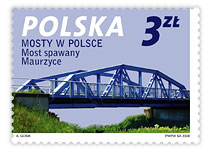 |
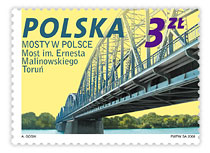 |
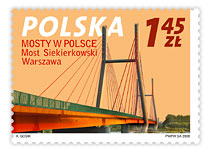 |
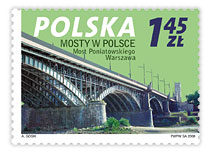 |
designer: Andrzej Gosik
number of stamps: 4
denomination: 2 x PLN 1.45, 2 x PLN 3
print run: 500,000 pcs each
printing technique: offset
stamp size: 43 x 31.25 mm
paper: fluorescent
selling sheet: 16 stamps
issue date: 29 August 2008
FDC

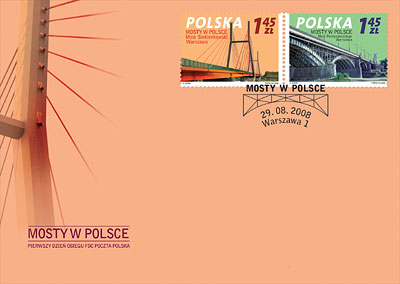
Dear collectors,
Bridges in Poland
A bridge is one of the earliest humans' ideas to overrule nature. The first bridges used to be as simple as spans of wooden logs fallen across a stream or precipice. Later they were made of ropes, beams and stones, and finally as sophisticated structures of iron, concrete and steel. Bridges are important elements of architecture; they are designed for transportation and strategic purposes.
New postage stamps and First Day Cover
The Polish Post presents a series of 4 stamps with famous Polish bridges constructed in the 19th, 20th and 21st century. The oldest one is a railway bridge in Toruń, and the other bridges are: Poniatowski Bridge in Warsaw, a welded bridge near Łowicz and Siekierkowski Bridge - the newest one in Warsaw. The stamps were printed in sheets of 4 stamps of each type. Two First Day Covers depicting parts of bridge structures were also issued. An occasional date stamp was issued and is to be used in the Post Office Warsaw 1.
Ernest Malinowski bridge in Toruń
An iron truss bridge for railway built between 1870-1873 to connect railway lines and serve as fortifications in a lower part of the Vistula river. It covers the so - called Stara Wisła and Kępa Bazarowa. Its 20 meter high towers were decorated with figures that were removed in 1920 as they reminded of the town's Prussian history. The towers themselves were disassembled in the 50's of the 20th century. By 1934 it was the only bridge in Toruń for trains, cars and pedestrians. The bridge was destroyed two times in the II World War - by the Polish troops (in September 1939) and then by the German troops (in January 1945). After the war, the bridge was rebuilt. In 1999 it was named by Ernest Malinowski - famous engineer who constructed a railway line in the Andes.
Poniatowski Bridge in Warsaw
Built between 1904-1914 as a Warsaw's third bridge on the Vistula river, designed by engineers M. Marszewski and W. Paszkowski and supervised by S. Szyller - author of the Warsaw University of Technology (Politechnika Warszawska) buildings. Its characteristic features are neo-Polish renaissance towers and pavilion on the viaduct over Powiśle. Poniatowski bridge was seriously damaged in 1915 by the retreating Russian troops and rebuilt in 1921-1926. It was on this bridge when in 1926, during the May Coup d'Etat, Józef Piłsudski met Stanisław Wojciechowski. The bridge was for the second time destroyed by the German troops during the Warsaw Uprising in 1944. Poniatowski bridge was rebuilt after the war (in 1946), however in a poorer shape, without decorative balustrades and some benches.
Bridge in Maurzyce
The first welded bridge in the world was designed by engineer Stefan Bryła in 1928. It was built on the Słudwia river (left Bzura's tributary). Welding significantly decreased the bridge's weight; earlier steel elements used to be joined by rivets or bolts. The bridge's weight is 55 tons.
Siekierkowski Bridge in Warsaw
Built between 2000-2002, however planned already during the interwar period. It is one of the elements of the 8-km long Trasa Siekierkowska yet to be finished. This seventh bridge on the Vistula river is a cable-stayed bridge supported by two pylons, with no pillars in the river current. Its characteristic orange cables are to warn and protect birds against any crashing.
Polish towns and cities - Jelenia Góra
designer: Andrzej Gosik
number of stamps: 1
denomination: PLN 3.65
print run: millions in multiple issues
printing technique: rotogravure
stamp size: 25.5 x 31.25 mm
paper: fluorescent
selling sheet: 100 stamps
issue date: 1 August 2008
FDC

Dear collectors,
Polish towns and cities- Jelenia Góra
History
In the place where two rivers Kamienna and Bóbr join, in a valley surrounded by the Izerskie, Kaczawskie and Karkonosze mountains, lies a city called "Pearl of the Karkonosze Mountains" (Perła Karkonoszy) - Jelenia Góra (previously Hirschberg). A traditional Latin inscription on a town hall says: "The city was built by Bolesław Krzywousty in 1108". In the 13th century the settlement was granted civic rights. In the 16th century it was famed for the production of linen as well as mining and metallurgy. During the Thirty Years War (1618-1648) the city was heavily damaged. Thank to textile industry and trade it got up and enriched. Another crisis came in 1742, when Silesia became incorporated into Prussia and later on Germany. From the 18th century Jelenia Góra made use of its development of tourism and that is when more hotels, restaurants and shops appeared. In the 2nd half of the 19th century railway led to Jelenia Góra.
Jelenia Góra is also a tourism base on these days. Main city places are: those of the medieval times (e.g. remains of the fortifications and a 16th century church by the saints Erasmus and Pancras) and of the baroque (e.g. city square tenement houses) as well as green areas and a famous Cieplice health resort with hot springs.
This year an additional attraction in Jelenia Góra is the celebration of the city's 900 years of history and for this occasion many concerts, historical event, market, outdoor and sport events will be organized. A jubilee local ducat has been issued.
New postage stamp and First Day Cover
The philatelic values, issued by the Polish Post on account of the celebrations of 900 years of the history of Jelenia Góra, depict characteristic historical objects: a stamp shows a town hall and the Neptune fountain, and the First Day Cover presents the Chojnik castle.
A previous town hall was burnt in the 17th century. When in 1739 a strong wind blew down a rebuilt tower of the town hall, the decision was made to build a new building. In around 1750 a new classicistic building of the town hall was erected on the remains of the medieval tenement houses based on the design of Ch.G. Hedemann.
A baroque fountain of Neptune built in a place where a city well was sunk, is a symbol of trade contacts of merchants from Jelenia Góra with overseas.
The Chojnik castle on the Chojnik hill (627 m. AMSL) was built in the 16th century in the times of the Piast dynasty duke Bolko II. The castle was then developed by the Schaffgotsches but it burnt down in 1675. Now it invites visitors. Every year knights cross-bow tournaments are held there.
An occasional date stamp with a coat of arms of Jelenia Góra will be used in the Post Office Jelenia Góra 1.
Philately
Jelenia Góra appears for the first time on a presented postage stamp and is the 19th city in the series the "Polish towns and cities" issued by the Polish Post since 2002.
The XXIX Olympic Games - Beijing, China 2008
 |
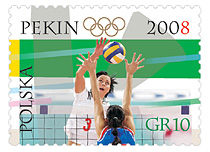 |
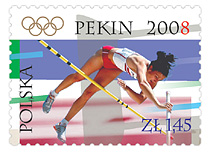 |
 |
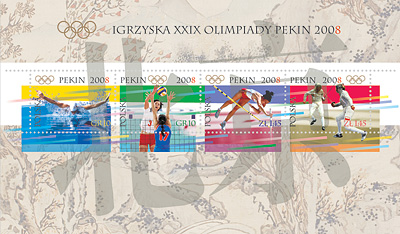 |
author: Janusz Wysocki
number of stamps: 4
denomination: 2 x 10 gr (PLN 0.10), 2 x PLN 1.45
print run: 750.000 pcs each
two printing formats:
- 500,000 pcs in selling sheets containing 20 stamps each
- 250,000 pcs in selling sheets containing 4 stamps each, with a dry press imprint in the upper margin area
printing technique: offset
stamp size: 43 x 31.25 mm
paper: fluorescent
issue date: 8th August 2008
FDC
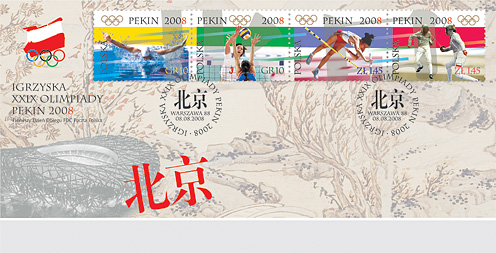
Dear collectors,
The Beijing Olympic Games
From 8 to 24 August this year the eyes of the world are turned to the city of Beijing. In 2001, the International Olympic Committee decided to appoint the Chinese capital as the site of the summer olympic games. The location has been the reason for much controversy. China is a fascinating country with an inspiring history and a rich culture, and also a global economic power. But it is also a state where the system of government and the observance of human and civil rights have long been contested by the international opinion.
Despite the controversies caused by the decision of the IOC, the olympic games is undoubtedly a true feast for sport lovers. The slogan of the Beijing olympics is "One world - one dream". The Polish olympic team comprises 263 athletes, and is the largest in the last 28 years! The Polish Post is one of the sponsors of the Polish Olympic Team at the Beijing Olympic Games 2008.
New postage stamps and First Day Covers
The stamps issued to commemorate the olympic games present 4 out of the 28 olympic disciplines: swimming, volleyball, the pole vault and fencing - it is those particular sports that our representatives are most hopeful to win medals in. The stamps are placed together in a block on the background of a traditional Chinese wood carving and the word "Beijing" written in its original form.
The design of the First Day Cover includes the same illustration, added with a photograph of the new Beijing stadium called the "Bird's Nest".
An occasional date stamp will be used, as a matter of exception, in the 88 Warsaw Post Office (at 10 Melomanów Str.). Eight is considered a lucky number in China. It is no coincidence that the games start on 8 August 2008, at 8.08 pm local time. Number "8" was also specially emphasised in the design of the Polish Post stamps. We would like it to bring good luck to our athletes, too.
Philately
The Polish Post has been issuing postage stamps related to the olympic games since 1956. It was then that a series of 6 postage stamps, commemorating the 16th Olympic Games held in Melbourne, was issued. An additional stamp, depicting the record 6.35 metre long jump by Elżbieta Krzesińska and the gold medal awarded for that result, was issued immediately after the Melbourne games. During the next couple of months, the Olympic Centre of the Żoliborz district in Warsaw will house an exhibition of all the olympic stamp issues.
Polish towns and cities - Racibórz
 |
designer: Andrzej Gosik
number of stamps: 1
denomination: PLN 1.45
print run: millions in multiple issues
printing technique: rotogravure
stamp size: 25.5 x 31.25 mm
paper: fluorescent
selling sheet: 100 stamps
issue date: 1st July 2008
FDC
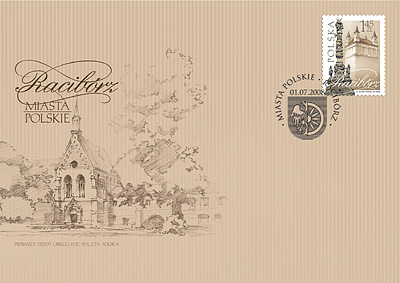
Dear collectors,
Polish towns and cities - Racibórz
History
The first mention of the town being captured by the knights of Bolesław Krzywousty in 1108, found in the Chronicles and Deeds of the Dukes or Princes of the Poles by Gallus Anonymous, is the reason for this year's celebration of the 900 years of history of Racibórz. Racibórz is located in south-western Poland by the river Odra. Due to its location in the vicinity of trade routes, it was very significant in the Middle Ages as a centre of craftsmanship and the venue for the largest grain market in the entire region. In the 12th century, Racibórz was the seat of the castellan's district ("kasztelania" - a mid level local administration unit in the Middle Age Poland, with a castle or an important town at its centre) and subsequently the capital of the Racibórz Principality. It was ruled by the Piast Dynasty (until the 14th century), the Przemyslid Dynasty, the House of Habsburg (beginning with the 16th century), later it was in the hands of the Prussians (the 18th century) and the Germans, and beginning with 1945 it has been a part of Poland. Racibórz was heavily damaged in the course of the Thirty Years' War, and subsequently ruined in 1945. In July 1997, 60% of the area of the town was under water as a result of a massive flood. Presently Racibórz is an industrial centre, known for the fact that it was the first Polish and European city to obtain the ISO 14001 quality certificate used in eco-management. Apart from many historical sites, the town's assets include a well developed infrastructure for sports.
New postage stamp and First Day Cover
The postage stamp, issued by the Polish Post on account of the celebrations of 900 years of the history of Racibórz, depicts two characteristic elements.
The first one is a renaissance tower (a prison) erected around 1574. As a distinctive feature of the town, the tower is included in its logotype.
The second element depicted on the stamp is a late-baroque Marian column, carved in sandstone by Jan Melchior Österreich between 1725 and 1727. It was ordered as a votive offering to Virgin Mary in gratitude for the end of the epidemic in 1715. On the top of the column, consisting of carved clouds, there is a figure of the Virgin Mary. A triple sided pedestal at the base of the column contains the figures of patron saints: St. Marcel - a pope and patron of Racibórz, St. Florian - a patron of fire fighters and St. Sebastian - defender against plague. The column was miraculously saved from war damage even though it stands in the centre of the town square and the tenements surrounding it were all destroyed.
The First Day Cover shows the Chapel of Thomas Beckett dating back to the end of the 13th century, referred to as the pearl of the gothic architecture of Silesia (the Śląsk region). It's a renovated part of the gothic-renaissance castle of the dukes of Racibórz. A general renovation of the building has recently been launched.
The occasional date stamp used in the Racibórz Post Office contains the town's coat of arms, depicting half of an eagle and half of a wooden wheel.
Philately
The "Polish towns and cities" (Miasta Polskie) philatelic series begun in 2002 with the issue of a collection of stamps related to the Polish capitals - Gniezno, Krakow and Warsaw. Later, also the town of Płock, and the oldest Polish city - Kalisz, were presented on postage stamps. Raciborz is the 18th town in the series.
Sanctuaries of St. Mary - St. Mary of the Snow
 |
designer: Maciej Jędrysik
quantity of stamps: 1
denomination: PLN 1.35
issue: 400.000 pcs
printing technique: offset
size of stamp: 31.25 x 39.5mm
paper: fluorescent
selling sheet: 16 stamps
date of circulation: 21th June 2008
FDC
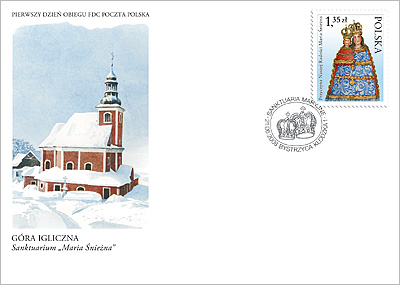
Dear collectors,
Sanctuaries of St. Mary - St. Mary of the Snow
The Igliczna Mountain Sanctuary
The Igliczna (Needle) Mountain is located in the Sudety Mts., in vicinity of the major peak Śnieżnik (Snowy Mt.). Nearby its top there is the small late baroque church, being a sanctuary of St. Mary Mother of God, the Cause of Our Joy "Mary of the Snow". The pilgrims come here to attend the wooden figure of St. Mary with Holy Child - a folk copy of St. Mary's figure from the Mariazell sanctuary in Austria. The figure had been brought in here in 1750 by Christopher Veit from Wilkanów village, as the changing national borders made the direct pilgrimage Mariazell sanctuary almost impossible for the local people. Originally, the figure was placed under an old beech tree and only fifteen years later, when the tree fell down due to the fierce wind storm, the rescued carving had been enshrined in a specially built wooden chapel. In 1777 the first case of miraculous healing had been documented, followed then by many others. The chapel soon proved to be too small for the ever-growing hosts of pilgrims and the new church had to be erected, consecrated in 1782.
Mary of the Snow
The name of this sanctuary is connected with the legend from early Christianity, according to which in midsummer, on August 5, the snow had fallen in Rome right in place where the first church for Holy Virgin should be built. The sign was earlier heralded by the dream, shared by the pope Liberius and Roman patrician Giovanni (John) who later became a constructor of that church, known as Santa Maria Maggiore as well as Santa Maria della Neve (of the Snow).
The church in the Sudety Mts. was named so also because of its mountainous location. Its builders had to work in haste with the first snowfall on their minds.
The St. Mary's of the Snow day is celebrated on August 5.
Coronation of the miraculous figure
On June 21, 1983 the sanctuary had been honoured in particular way by pope John Paul II who crowned the figure of St. Mary of the Snow and conferred on her the title "The Cause of Our Joy". The crowning ceremony took place in Wrocław. Although the pope did not visit then the sanctuary on the Igliczna Mt. in person, he used to be there a few times previously in the 50s and 60s as the priest Karol Wojtyła, a great advocate of St. Mary's cult.
The new stamp and the FDC envelope
In the 25th anniversary of coronation of the figure from St. Mary's of the Snow sanctuary Poczta Polska has issued a stamp, featuring the figure kept usually at the top of the Igliczna Mt. church altar. The FDC envelope presents a winter view of that church, while the motif of crowns adorning the figure was used in the occasional postmark, being applied at Bystrzyca Kłodzka 1 Post Office.
Philately
Including the last year's issue of "Celebration of the Leśniów Jubilee Year", the present stamp is the 40th issue from 1993, envisaging the figures or paintings venerated at the St. Mary's sanctuaries in Poland.
World Philatelic Exhibition EFIRO 2008
 |
designer: Kuba Sowiński
engraver: Przemysław Krajewski
quantity of stamps: 1 in form of a block
denomination: PLN 3
issue: perforated block - 360,000 pcs
imperforated block - 60,000 pcs
printing technique: steel engraving and rotogravure
size of stamp: 43 x 31.25 mm
size of block: 90 x 70 mm
paper: fluorescent
date of circulation: 20th June 2008
FDC
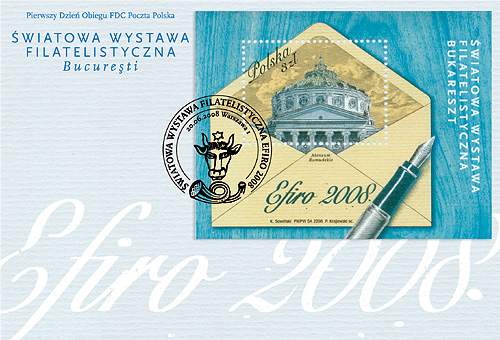
Dear collectors,
World Philatelic Exhibition EFIRO 2008
EFIRO Ehxibitions
The first EFIRO (Romanian Philatelic Exhibition) had taken place in 1932 on an occasion of the 70th anniversary of unification of the Moldavian and Multanian Post Services. That event was inspired by the "Philatelic Tribune" magazine, and was carried out under patronage of the king Carol II.
The occasion to organize the next EFIRO Exhibition (1998) had been given by the 150th anniversary of 1848 revolution and the 140th anniversary of issue the first Romanian post stamp. Finally the third EFIRO Exhibition (September, 2004) took place on an occasion of the 130th anniversary of establishing the Universal Postal Union (UPU) in connection to its 23rd congress.
The actual EFIRO exhibition is therefore the fourth one in that line, accompanying at the same time the World Philatelic Exhibition, being hosted by Romania for the first time. The exhibition organized under the motto "Time goes by, stamps remain" will be held in an exhibition centre Romexpo on June 20-27, 2008, where one day after its final conclusion the FIP (Fédération Internationale de Philatélie) congress will assemble.
The new stamp and the FDC envelope
Immediately on the opening day of the EFIRO 2008 exhibition Poczta Polska has issued the stamp in block, featuring an open envelope, out of which the fragment of the Romanian Athenaeum building can be seen. Off the stamp's frame there is an image of fountain-pen with its nib decorated with the engraved aurochs' head.
The Romanian Athenaeum
The concert hall, built partially thanks to the public subscription to become a national temple of sciences and art. Currently it is a home of the Romanian Philharmonic. Nowadays the Atheneaum is a symbol of the national tradition and culture in dominated by the social-realistic architecture Bucharest. It was built at the end of the 19th century in neoclassical style by the design of French architect, A. Galleron.
Philately
To promote in its own country the World Philatelic Exhibition the Romanian Post in the years 2006, 2007 and 2008 has prepared special issues, featuring the first Romanian stamps. Among them the block issued in 2007 and introducing the EFIRO 2008 Exhibition shows an outstanding layout as the stamp axis declines by ten degrees from the edge of the block.
The head of an aurochs (or an European bison) with a star in between its horns is the national emblem of Moldavia and as such it is an element of the Romanian national coat of arms. The "bull head" stamp, although issued in 1858 by the Moldavian Post, is generally recognized as the first Romanian stamp as well. The official date of its first issue is July 15, 1858 which had been reprinted in the period from November 1, 1858 - May 1, 1862.
Esfahan - the City of Polish Children
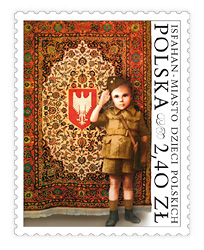 |
designer: Maciej Jędrysik
quantity of stamps: 1
denomination: PLN 2.40
issue: 400,000 pcs
printing technique: offset
size of stamp: 31.25 x 39.5 mm
paper: fluorescent
selling sheet: 16 stamps
date of circulation: 10th June 2008
FDC

Dear collectors,
Esfahan - the City of Polish Children
Esfahan
The city in central Iran by the foot of the Zagros Mountains, between the end of the 16th and the half of the 18th centuries the capital city of Persia. The great center of manufactures, famous of its beautiful carpets, metal wares and ceramics (decorative tiles and mosaics). Its architectural remains (palaces and bridges) from the period of Safawid dynasty are also the real attractions for tourists.
The Polish - Iranian Contacts
Although Iran (formerly Persia) is a far away country, since renaissance the Polish rulers tried to establish the closer military ties with Persian shahs, in particular to enter with them into alliance against Turkey. Those plans, however, had never came into realization but at least they helped to develop quite animated trade exchange, and indeed, the Persian carpets and weapons were truly worthy of royal treasuries.
Moreover, the Polish missionaries used to be active in Persia, and in the 19th century many of Polish emigrants: scientists, engineers, doctors and officers have found their homes in that country; in 1926 the Association of Poles in Persia "Polonia" has been established in Tehran.
The Period of World War II
During the World War II to Iran together with the created in the USSR Gen. W. Anders' army have come thousands of exiles, including great number of little children, mostly orphans from the former Polish eastern territories. For some 13 000 of them who had not died of emaciation or illnesses that country became for a few years their temporary home and most of all a refuge to survive the war-time. In Esfahan the years 1942-1945 have spent 2590 Polish children below 7, for whom were arranged various educational institutions, such as nurseries and primary schools, and even a sanatorium. By the end of the war the children had been evacuated in groups together with their protectors to many different countries: New Zealand, Lebanon, India, Mexico, Palestine, or British African colonies, from where most of them have never come back again to their homeland.
The vicissitudes of the Polish exiles have been recalled in 2005 by the IPN (Institute of National Remembrance) exhibition "Rescued from the >inhuman land<". The fates of Polish exiles from the USSR in 1942-1950", and by the collective book "Esfahan - the City of Polish Children", published in London. Their stay in Iran is also commemorated on the local cemeteries and commemorative plaques.
The New Stamp and FDC Envelope
Poczta Polska has issued a new stamp, commemorating the dramatic, sad and nearly forgotten in the face of the main events of World War II, fates of the Polish orphan children and yet somehow beneficial because of the aid, granted by the Persian citizens and authorities. The stamp features a portrait of one of those rescued children, Przemek Stojakowski, in front of the Persian carpet with Polish eagle motif in center. This very carpet has been woven in 1944 by the Polish girls from the Esfahan School of Weaving. On the FDC envelope an ornament from the typical Esfahan architectural detail stands next to the list of names of the Polish children exiles to Iran. The occasional postmark of this issue will be applied at Warszawa 1 Post Office.
World of Toys
 |
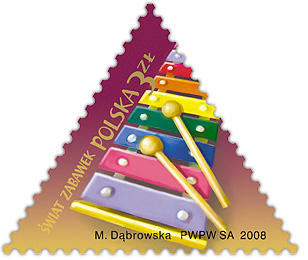 |
designer: Marzanna Dąbrowska
quantity of stamps: 1 x PLN 1.35, 1 x PLN 3
denomination: PLN 3, PLN 1.35
issue: 2 x 600,000 pcs
printing technique: offset
size of stamp: 33.04 x 32.34 x 32.34 mm
paper: fluorescent
selling sheet: 16 stamps
date of circulation: 1st June 2008
FDC

Dear collectors,
World of Toys
The oldest toys, found by the archaeologists in children's tombs, are about 2500 years old. The toys always mirrored the world of adults. In antiquity children played with miniature objects from everyday life and with the dolls. In those times the educational toys existed as well, such as Greek or Roman letters on a string, for example. Together with technological progress the first mechanical toys had been invented. Should the industrial revolution never happened, the boys would not played with model cars and trains. In the 19th century the first "walking" and "talking" dolls became available in the magazines. The real hits of the 20th century are undoubtedly the Barbie doll and the Lego bricks; nevertheless, the most universal toys are still the simplest and usually the cheapest ones, which the children do not get bored of too early. Such toys allow the children much freedom for their own invention and help to develop their imagination, at the same time being usually more damage-proof than the others. Therefore, apart from all that technological progress, TVs and computers, the kids are still fond of toys that were played by our parents and grandparents, and it may be hoped that they will remain favourites for the next generations, too.
The new stamps and the FDC envelope
On June 1, 2006 Poczta Polska has issued the first part of the series of stamps with toys, unusual first of all because of their triangular shape. This beautiful issue presents a few universal toys, for the times unknown constantly developing children's imagination. On the stamps of 2006 issue there were the toys, based on the use of spinning motion, i.e. a top and a pin-wheel, while in this issue there are the kid's dulcimer and the wooden choo-choo train (on the stamps), and the playing ball and the rocking horse (on the FDC envelope). Toys can be seen in the triangular stamp frame only partially, in their entirety they are only visible on the complete sheet of 16 stamps of one kind. The occasional postmark applied at Warszawa 1 Post Office includes an example of one more toy - a horse's head on the stick.
Children's Day
Celebrated annually in Poland and in a few neighbouring countries since 1952. In the world better known is Universal Children's Day (November 20), introduced by UN in 1954.
Philately
Triangular stamps are extremely rare in Polish postal currency. Beside the well known 1959 series "Polish Mushrooms" (8 stamps) and a part of the 1963 series "Polish Horses" (3 stamps out of 10) you can find them only among the issues from the times of the former foreign occupation of Polish territory, such as 1916 stamp of the municipal post of city Sosnowiec (featuring the city's coat of arms) or Austrian so called express stamps, being used even after regaining the independence in the years 1918-1919, in a form of the reversed triangle with a head of Mercury.
European Football Championship EURO 2008
 |
designer: Anna Niemierko
quantity of stamps: 1
denomination: PLN 1.35
issue: 600.000 pcs
printing technique: rotogravure
size of stamp: 31.25 x 43 mm
paper: fluorescent
selling sheet: 50 stamps
date of circulation: 30th May 2008
FDC

Dear collectors,
European Football Championship EURO 2008
Football - the most popular sport game in Europe - is simple, cheap, and above all brings about a lot of emotions for its players as well as for its fans. The European Football Championship take place every 4 years, just as the Olympic Games, and is organized by the Union of European Football Associations (UEFA), established in 1954. The first European Championship was organized in France in 1960 under the name of the European Nations Cup. Only the four best teams had taken part in it, and the winner was the USSR. The same rules were continued up to 1976, while in the years 1980-1992 the number of participants had been increased up to 8 teams, and since 1996 up to now there are 16 teams. In that number, beside the winners of final eliminations, there is a team of the host of actual championship. The final games are preceded by the qualifications in groups, starting as early as in the autumn two years before the date of championship. The championship popularity grows steadily with its every turn, since it used to bring about the most unexpected surprises, such as that of the 2004 games when the first place had been won by Greece. The matches of Euro 2008 are to be played in June 7-29 on the eight Austrian and Swiss stadiums.
The Polish contribution
This year Polish football fans may feel happy no matter what the final results of the Euro 2008 will be, as the national Polish football team has qualified to the final contest of the European Championship first time in its history. Moreover, in 2012 Poland will host (together with Ukraine) the games of the next European Championship, what guarantees participation of the Polish team again.
The main achievements of Polish football are: the 4th place at the 1936 Olympic Games, the golden medal at the Olympic Games in 1972, the silver olympic medals in the years 1976 and 1992, and the 3rd places at the World Cup in 1974 and 1982.
The new stamp and FDC envelope
On the occasion of the Euro 2008 Poczta Polska presents the stamp and FDC envelope adorned with an illustration, associating so well with an atmosphere of the crowded stadium stands, full of shouting fans with painted faces, what fits the official slogan of the white-and-reds at this championship: "... because only sport and good fun counts!". The issue is accompanied by an occasional postmark, being applied at the Warszawa 1 Post Office.
The philately
Poczta Polska had issued the stamps with football motives many times on the occasions of the World Cup and Olympic Games, and the particular Polish achievements, such as for example in 1974, when the special series of stamps with se tenant labels had been issued to commemorate successes of the coach Kazimierz Górski's team.
VII EUROSAI Congress in Krakow
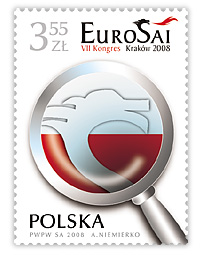 |
designer: Anna Niemierko
quantity of stamps: 1
denomination: PLN 3.55
issue: 400,000 pcs
printing technique: offset
size of stamp: 31.25 x 43 mm
paper: fluorescent
selling sheet: 16 stamps
date of circulation: 30th May 2008
FDC
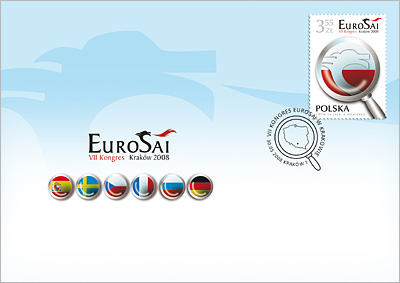
Dear collectors,
EUROSAI
The state audit and control institutions of all the world are united in the INTOSAI - International Organization of Supreme Audit Institutions. One of its eight regional groups is the EUROSAI - European Organization of Supreme Audit Institutions, uniting 48 such institutions. The EUROSAI congresses are held every 3 years, and the leadership of organization is usually taken over by the actual host. The next congress is to be held on June 2-5, 2008 in Krakow, Poland. The previous congresses have taken place in Madrid (1990 - the Establishing Congress), Stockholm (1993), Prague (1996), Paris (1999), Moscow (2002), and in Bonn (2005).
NIK
The Supreme Chamber of Control - is the most important state audit organization in Poland. Its main task is auditing the management of the public means. NIK reports annually on its activities to Sejm - the Lower Chamber of Polish Parliament.
NIK coordinates the activities of the EUROSAI Working Group on Environmental Auditing. During the Krakow Congress an important ecology-friendly novelty will be introduced: all the materials will be available in the electronic form, and not as a printed matter as before.
The new stamp and FDC envelope
On the occasion of the VII EUROSAI Congress and taking over by NIK the leadership of organization Poczta Polska has issued a special stamp with the Congress logo. The magnifying glass on that stamp is a symbol of audit. On the FDC envelope there are graphically processed flags of the 6 countries which up to now have hosted the previous congresses and consequently have played one by one a role of the EUROSAI leaders.
The author of the Congress logo, printed on the stamp and on the FDC envelope as well, in which the stylized dragon's head stands for the letter S, is Joanna Sowula, a student of the Academy of Fine Arts in Katowice, whose project has been chosen by the NIK representatives from among other prize winners. The stamp will be accompanied by the occasional postmark, applied at the Krakow 1 Post Office.
Europa
 |
designer: Joanna Górska
quantity of stamps: 1
denomination: PLN 3
issue: 500,000 pcs
printing technique: offset
size of stamp: 43 x 31.25 mm
paper: fluorescent
selling sheet: 16 stamps
date of circulation: 5th May 2008
FDC
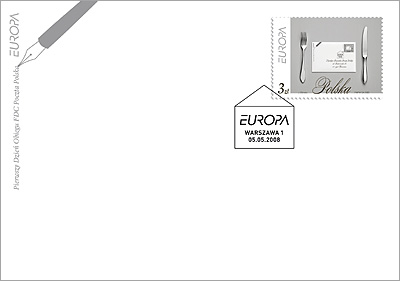
Dear collectors,
The EUROPA Stamps
The tradition of joint issues of the EUROPA stamps is over 50 years old now. In 1956 six postal operators of the original member countries of the European Union (Belgium, France, Netherlands, Luxembourg, Germany and Italy) have prepared a joint issue of the stamp with the word EUROPA in a form of a tower built of its letters. The joint issues have been continued recurrently up to 1973 always with common design with the leading themes such as: Europe, unity and peace, only gradually supplemented with some symbols of telecommunications. Since 1974 only Europe as the leading subject remained, and the stamps are designed by each country individually. The range of possible themes has become therefore much broader, including culture, famous personages, or inventions, but also some more general problems, such as nature conservation or the 500th anniversary of the discovery of America in 1992. The EUROPA stamps should on one side contribute on popularity of the community ideas while on the other side they should help in mutual understanding of the various traditions. Moreover, they underline cooperation of the European public postal operators, particularly in the domain of philately.
CEPT - European Conference of Postal and Telecommunications Administrations, an official sponsor of the EUROPA joint issues in the years 1959-92.
PostEurop - Association of the European Postal Public Operators. Exists since 1993 and it takes care about the EUROPA joint issues.
The 2008 Competition
The theme of the last year EUROPA competition was the 100th anniversary of the International Scout Movement, and its winner was the Armenian stamp. All the stamps taking part in this year's competition can be seen at the PostEurop web page and from May 9 until August 8, 2008 the voting is open for all to select your favourites. Two persons picked out from those that have selected the winning stamp will be granted special prizes - a full set of the 2008 EUROPA stamp issues. The winning stamp will be announced on November 13 during PostEurop's Extraordinary Plenary Assembly that will be held in Brussels, Belgium. The theme of the 2009 competition will be astronomy.
The New Stamp and FDC Envelope
As every year, Poczta Polska has prepared its EUROPA stamp, whose theme for this year is "a letter". The designing artist placed an envelope with the calligraphed address on the table, between knife and fork instead of a plate, and thus it became something that appeases hunger, although not a physiological one. After all the letters, as the photographs, are the material records of fragments of life, a moment to be remembered or an instant emotion, and therefore they are a piece of art, being at the same time a historical document. This particular way of communication may be only imperfectly replaced by the e-mail or internet chat. We used to come back to some letters after many years, they are also stored and recalled. This issue, reminding us about the value of the handwritten letter, is accompanied by an occasional postmark in a form of the addressed envelope, applied at Warszawa 1 Post Office.
The Meteorological Phenomena
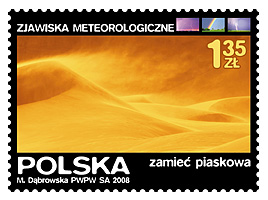 |
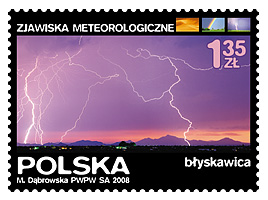 |
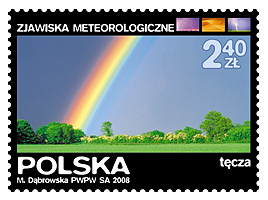 |
 |
designer: Marzanna Dąbrowska
quantity of stamps: 4
denomination: 2 x PLN 1.35, 2 x PLN 2.40
issue: 400,000 pcs
printing technique: offset
size of stamp: 43 x 31.25 mm
paper: fluorescent
selling sheet: 12 stamps
date of circulation: 25th April 2008
FDC

Dear collectors,
The Meteorological Phenomena
Since the earliest times people used to watch carefully the nature, trying to foretell by the clouds or animal's behavior, for example, the oncoming storm, rain or drought. Nowadays we just look at the TV weather forecast while planning an excursion or simply choosing the suitable dress for tomorrow and to be sure if we would need an umbrella. The weather influences our general frame of mind, but we have no influence on it, either. Not infrequently the nature shows us its tremendous power in the floods or hurricanes, for example. But there are also many meteorological phenomena that may pass unwatched for us, and sometimes it is simply worth to look at the sky to see something beautiful and unusual.
The meteorological phenomena as to their nature: hydrometeors (rain, hail, frost, tornado), lithometeors (dust or sand blizzards or whirls), photometeors (halo, rainbow, mirage), electrometeors (storm, lightning, aurora borealis)
Meteorology - a branch of science, investigating the atmospheric phenomena. Based on the results of measurements of the main parameters (such as the air temperature, humidity, and pressure together with the wind speed) and the data, provided by the radars, air probes and satellites the complex analysis (today mostly computer-aided) is executed of their complicated mutual influences. Its results, or synoptic prognoses, are indispensable for the different sectors of country's economy, as in agriculture, for example, in order to avoid the catastrophic crops losses, or simply in the flight control.
Sand blizzard - the sand being carried up high above the ground level by the strong, hot wind. It can be very arduous for the inhabitants of the desert areas.
Lightnings - The atmospheric electric discharges, born in the high rainclouds (cumulonimbus) in the result of the great temperature gradient and the strong wind. The lightning in fact is an electric spark, zeroing the charge difference between the cloud and the earth or between two individual clouds.
Rainbow - an arch of the diffracted sunlight. It emerges in the result of refraction, diffraction and the total internal reflection of solar rays in the small raindrops in the atmosphere. It is visible only if the Sun shines from behind of the observer and is sufficiently low (less than 40 degrees) above the horizon.
Tornado - a great funnel shaped whirl of air and liquefied water vapor, reaching up to the clouds. It rotates with enormous speed (400 km/h, for example, and creates giant difference of pressure inside. If it touches the earth, it destroys everything on its way, leaving behind a few hundreds meter wide trace of ruins on a distance of some 10-20 km.
The new stamps and the FDC envelope
The presented here four-stamp series shows the beauty of meteorological phenomena as fixed on the photographs. The graphic layout suggests that the slides have been shown in such a way to enhance their contrast and colors. Each stamp presents one phenomenon representative for each of the above mentioned groups hydrometeors, lithometeors, photometeors and electrometeors. On the FDC envelope the similar slides can be seen as lying on the back-light table. Their evaluation and choice of the best ones is suggested by the magnifying glass nearby. This emission will be accompanied by the occasional postmark (featuring a letter tornado-shaped composition), applied at Warszawa 1 Post Office.
Polish Aviation in Tradition and Today
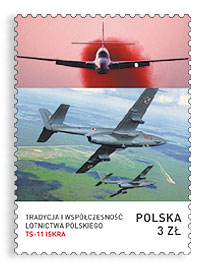 |
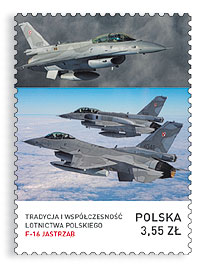 |
designer: Jerzy Skakun
quantity of stamps: 2
denomination: PLN 3, PLN 3.55
issue: 2 x 600,000 pcs
printing technique: offset
size of stamp: 31.25 x 43 mm
paper: fluorescent
selling sheet: 8 stamps
date of circulation: 31st March 2008
Koperta FDC
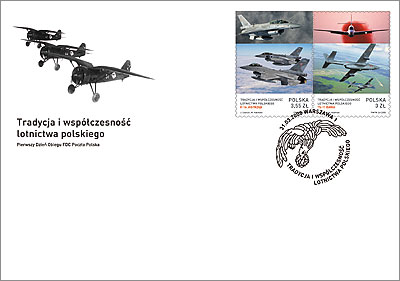
Dear collectors,
Polish Air Forces
The history of aviation is in fact the history of the 20th century. It had begun with the first successful flights of the Wright brothers (since 1903 on) and in 1911 the planes were first used in the battle. Further development of aviation was sped up by the two World Wars. For a long time, however, the planes were used only as a support and cover for the infantry troops as well as for the reconnaissance purposes. Nevertheless in the days of World War II the air forces became already a key factor in the struggles of the involved parties. Thousands of bombers and fighters had been produced over that time.In Poland the air squadrons were organized since the first days of independence, although initially only abroad as in France, for example. Beginning from the 1930s the first aeroplanes constructed entirely in Poland (such as PZL P.7a, PZL P.11c, PZL.23 Karaś ("Crucian carp"), and PZL.37 Łoś ("Moose") had been introduced to the army, which in 1939 had about 750 planes. After the September campaign most of the rescued pilots and equipment were evacuated off the country. Some of the Polish pilots took part in the Battle of Britain in 1940, where they had won a considerable renown (the squadrons 302 and 303 in particular).
After the War the new formation of the National Air Defense have been established. The Polish Army remained up to 1989 under strong influence of the USSR. Therefore it used mainly the Soviet machines of the MiG, Tu and Su types. In the 1950s the first jet planes had been introduced, and in the 1960s the supersonic planes as well. Since entering the NATO structures in 1999 the Polish Air Forces are continuously being updated and adapted to conform the new requirements.
The new stamps and FDC envelope
Poczta Polska presents two new stamps with the airplanes, in use in the Polish Air Forces: TS-11 Iskra ("Spark") and F-16. The illustration on the FDC envelope reaches still further back into history as it features 3 high-wing monoplane fighters PZL P-11c, designed and constructed in Poland. The occasional postmark to be applied in Warszawa 1 Post Office bears a well known motive from the pilot's badge - a flying eagle with the laurel wreath in its beak.
The TS-11 Iskra Airplane
The one-engine jet training airplane, designed in the late 1950s by Dr. Eng. Tadeusz Sołtyk team at PZL Okęcie works. It is equipped in one 23mm machine gun and two rocket launchpads. In the 60s four world records have been beaten by that plane. Apart from military training, its different versions were applied also for civil and aerobatics purposes. For some time the plane was at use by the Indian Air Forces. The TS-11 airplane finally came out of production in 1987.
The F-16 Fighting Falcon Airplane
The multipurpose jet fighter plane of the American origin (General Dynamics Co., currently a division of Lockheed Martin Corporation). Since the late 1970s more than 4500 F-16s were produced. It is the most popular fighter plane in the world, used by the air forces of 25 countries. It is famous of its acceleration, maneuverability, advanced avionics and relatively comfortable service, a rare thing at enormous gravitational overloadings. In the next few years Poland expects to increase its air force by 48 F-16 C/D Block 52 Advanced airplanes.
The 80th Anniversary of the Straż Graniczna (Border Guard)
 |
designer: Jerzy Skakun
quantity of stamps: 1
denomination: PLN 2.10
issue: 500.000 pcs
printing technique: offset
size of stamp: 31.25 x 39.5 mm
paper: fluorescent
selling sheet: 20 stamps
date of circulation: 22nd March 2008
Koperta FDC

Dear collectors,
Straż Graniczna (Border Guard) - A police-type (civil-military) formation, dedicated to keep watch over the country's frontier and to control the cross-border traffic. Apart from the land border zone it is active in the sea harbours and international airports.
The Frontier Guard functionaries' equipment includes modern spyglasses, universal ground as well as air and water vehicles, and special systems of luggage control and detecting the forged documents. The specially trained dogs prove also to be very helpful, in particular in finding the smuggled drugs and narcotics.
Protection of the Polish borders in the 20th century
When Straż Graniczna had been brought into being Poland existed since only a few years as an independent state after more than a century of partition and foreign occupation. Particularly unstable zone was its eastern frontier with Soviet Union. The Polish Government was permanently searching to establish structures ensuring in the best way the safety of frontiers as well as the control of international human and trade traffic. Up to the Second World War such a role was played by different, mostly military formations. In the East for example the frontier had been guarded by Korpus Obrony Pogranicza (Border Defence Corps), called up in 1924. The more stable northern, western, and southern frontiers required in the beginnings rather civil guards, the situation had changed however in the end of the 20s. Due to the political tensions in contacts with Germany and Czechoslovakia, on March 22, 1928 the president of Poland, Ignacy Mościcki, had called up in the place of formerly existing Straż Celna (Custom Guard) the new Straż Graniczna, being subject to the ministries of the Treasury, Internal and Military Affairs which remained up to 1939.
After the war the Polish frontiers were again guarded by the specialized Army forces until 1990, when their role have been taken over by the revitalized Straż Graniczna. Accession the EU by Poland has brought about some important changes in the international traffic. The eastern frontier of Poland has become the outer frontier of the EU, what requires an increased control over the smuggle of narcotics and weapons as well as the illegal migration. The Polish membership in the EU relates with joining the Schengen Agreement. Since December 2007 there is no check up at crossing the land and sea borders to the other Schengencountries, and since March 30, 2008 the same rule is in force in the airports. These privileges mean also the security co-operation, unification of regulations and access to the common database.
The new stamp and the FDC envelope
On the occasion of the 80th anniversary of establishing the Frontier Guard Poczta Polska has issued a stamp with the motif of border pole, painted in white-and-red strips and with a state emblem. The FDC envelope bears an archive photo of the Frontier Guard representation on the celebration of the Independence Day, November 11, 1929 in Warsaw, from the collection of the Regional Museum at Piła, containing many more similar documents on the activity of the Frontier Guard in the Noteć River region. The issue is accompanied by an occasional postmark applied at the Warszawa 1 Post Office.
Easter
 |
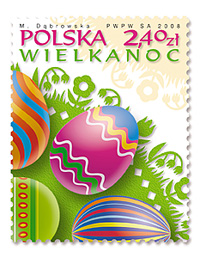 |
designer: Marzanna Dąbrowska
quantity of stamps: 2
denomination: 1 x PLN 1.35, 1 x PLN 2.40
issue: PLN 1.35 x 2.000.000 pcs
PLN2.40 x 20.000.000 pcs
printing technique: rotogravure
size of stamp: 30 x 39 mm
paper: fluorescent
selling sheet: 50 stamps
date of circulation: 29th February 2008
FDC
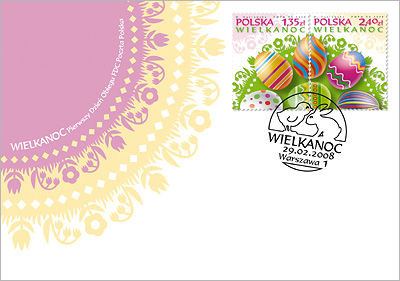
Dear collectors,
Easter greetings
The most important in the Catholic Church holiday, the day of Jesus Christ's resurrection, in calendar coincides with the beginning of spring, and therefore its symbolism, although Christian, includes the traditional springtime elements as well. In order to enrich the holiday correspondence Poczta Polska since 1997 issues each year the special Easter stamps. The stamps feature usually religious scenes, folk customs and different symbols of the life reborn, such as painted eggs, chickens and the flowers and green plants. This year's your holiday greetings, mailed on the postcards or in letters, will be completed with colourful and optimistic stamps, being a perfect illustration of the universal joy, brought about by the celebration of Easter time.
The new stamps and FDC envelopes
Poczta Polska presents the Easter duo of stamps in the spring and holiday tones. On both of them there is shown a composition of painted eggs and paper cut-outs; similar cut-out in two colours, decorates the FDC envelope. For this issue the occasional postmark has been prepared with the motifs of chicken and baby rabbit, to be applied at the Warszawa 1 Post Office.
The contemporary Easter eggs
Such eggs as shown on the stamps do not necessarily copy the traditional patterns. Nowadays they are rather unique creations of the individual artists, depending on their own invention. Among them one may find all conceivable painting techniques, applied to the ostrich or geese eggs. There are also carved shells of blown eggs or the eggs "dressed" in laces or knitted wool.
The folk cut-outs
The paper decorations made by cutting out the holes precisely in the piece of paper, folded many times, what results in highly symmetrical patterns. This kind of holiday decorations is popular in Poland mainly in Masovia (region of Kurpie and vicinities of Łowicz and Opoczno) since the end of the 19th century, as earlier the paper was not available universally. The cut-outs, originally white and only later in different colours, used to be affixed to the peasants houses' walls before all the major holidays. Their motifs range from the abstract geometrical forms to the plant or animal representations. Their precision attains sometimes amazing level considering that they were made frequently with the sheep shearing scissors.
A History of Polish Photography
 |
 |
 |
 |
designer: Jacek Konarzewski
quantity of stamps: 4
denomination: 4 x PLN 1.35
issue: 4 x 500,000 pcs
printing technique: offset
size of stamp: 31,25 x 43 mm
paper: fluorescent
selling sheet: 12 stamps
date of circulation: 29th February 2008
FDC
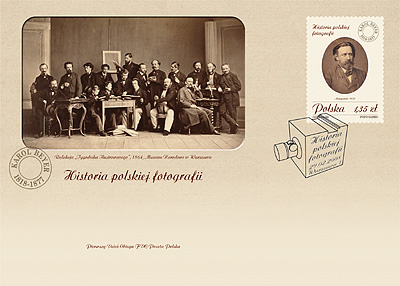
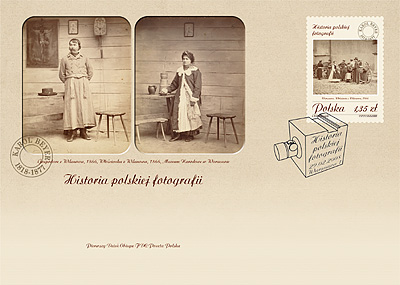
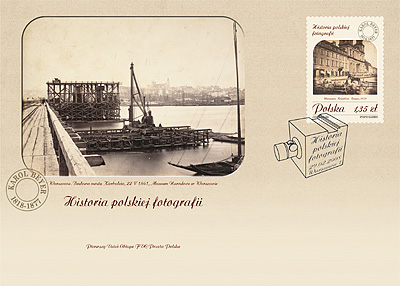

Dear collectors,
Karol Beyer (1818-1877)
This "father of Polish photography" as a young man studied painting and worked in the artistic cast factory. In 1844 he left to Paris to learn there the daguerrotype technology. Soon he had opened his own workshop in Warsaw, producing the daguerrotype portraits, which after a few years transformed into a real photo atelier. At the peak of his career Beyer employed as many as 30 photographers, some of them being talented artists. In this way he had educated many renowned professional photographers. The photography in Beyer's atelier was recognized as an art, what had been attested by numerous awards won at the international exhibitions, but also as a mean of documentation. One of Beyer's partners had won great popularity for his posthumous portraits of the victims of 1861 patriotic manifestation and the photographs from the period of the January Uprising. For his patriotic engagement Beyer had been sentenced for two year's banishment in the remote region of Russia.
Beyer participated also in establishing the "Tygodnik Ilustrowany" ( "Illustrated Weekly") magazine and developed for it his own technology of transferring the photographs (by mediation of the negative) onto the wooden printing blocks; he worked on the modern collotype technology as well. He was much interested in numismatics and archaeology. At the age of 54 however he retired from photography.
The daguerrotypy
The photography's "elder sister" consists in producing pictures on the silver-coated plates, covered with a photosensitive material. Its name comes from its inventor, Louis Daguerre. This technology had been in use for some 10 years only and required high precision as well as technical and chemical skills. Since its beginnings it proved also to be dangerous for health and life for the use of mercury vapours in developing process. Unlike photographs, the daguerrotypes could not be reproduced.
The early photography
Officially the photography was born on 1839. The glass negatives could be copied on specially prepared paper. The collodion process so called "wet plate", in use universally in the 2nd half of the 19th century, required from the photographer to carry with him a kind of a portable dark room in order to avoid drying out the photosensitive material. As the photos were not yet blown up, and the copies were made by direct contact, it was necessary to use cameras of different sizes. The portraits were made most frequently in the so called visiting (6.5x10 cm) and cabinet (10x15 cm) sizes. The static appearance of early photographs is due mainly to their long exposure times - up to even almost twenty minutes.
The new stamps and FDC envelopes
On the occasion of the 190th anniversary of Karol Beyer's birth Poczta Polska has issued 4 stamps with reproductions of his photographs from the National Museum in Warsaw collection. The stamps present the Author's self-portrait (1858), portraits of peasants from Wilanów (1866), the Holy Cross church in Warsaw (1858) and Russian army at the Castle Square in Warsaw (1861).
The accompanying 4 FDC envelopes feature the photos of the "Tygodnik Ilustrowany" magazine staff (1864), a pair of peasants from Wilanów (1866), the Kierbedź bridge under construction (May 22, 1861) and the monument of the king Jan III Sobieski (1858). A picture of the bridge is, in a sense, one of the first report's photos, as Beyer documented that enterprise over all the time of its realization (1859-1864). The emission is completed with an occasional postmark in a form of the simple photo camera, applied at the Warszawa 1 Post Office.
I Love You

designer: Marzanna Dąbrowska
quantity of stamp: 1
value: 1.35 PLN
issue: 2.000.000 pcs
printing technique: offset
stamp size: 43 x 31.25 mm
paper: fluorescent
selling sheet: 20 stamps
circulation date: 7th February 2008
FDC
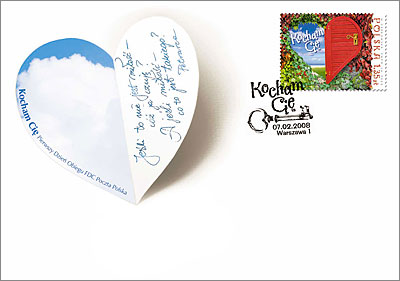
Dear collectors,
St. Valentine's Day
Although this Lover's Holiday is imported from the West, it has achieved in Poland great popularity, in particular among the young people. It is the best opportunity to show someone our sympathy or to make a nice surprise with unexpected gift or letter. As it is generally much easier to express someone's feelings in writing, St. Valentine's Day opens an opportunity for the shy and timid people.
St. Valentine
He was a Roman bishop of the 2nd/3rd centuries AD, recognised originally as a patron of the suffering of epilepsy and related illnesses. Only later, due to the pious legends about his care for the young lovers, whom he used to marry even against the Emperor's will, he became a patron of those being in love as well.
Tradition of the St. Valentine's Day Correspondence
Love letters are probably as old as the art of writing itself but in the course of time they became more and more elaborated. Such a letter could be perfumed, adorned with laces or hand-made pictures, or even encoded. Such preparations required much work and time, of course, so in the half of the 19th century came into use the ready-made Valentine postcards. Obviously, they were richly decorated with hearts, cupids, doves, and flowers together with standard sentention "From your Valentine". Usually, such postcards were not additionally undersigned in any other way.
The Valentine's stamps had been issued all over the world since some 20 years already. In 1999 the French Post has issued the first stamps in the shape of a heart and although they were hard to detach not breaking their perforation, they looked perfectly well while applied at the letters or postcards. Poczta Polska issues the occasional stamps for St. Valentine's Day for 15 years as well. Frequently they bear a heart motif, but there were also stamps with flowers, fruits and butterflies, and even stamps featuring pictures of a dog and a cat.
The new stamp and the FDC envelope
As the rational thinking do not go in pair with love, the picture on this St. Valentine's stamp do not relate much with reality, being taken more from the world of fairy tale or a dream. Here we can see an entrance to the land of love, peace and joy, for the garden gate when opened takes upon a shape of heart. The key to this gate is hidden in the postmark (applied in the Warszawa 1 Post Office). On the FDC envelope there is a postal symbol, an open postcard in the form, similarly to the mysterious gate, of a heart. Close to the white clouds one can find in this pictured card the handwritten passage from Petrarca's sonnet 132: "If it is not love, what then is it that I feel? But if it is love, what kind of thing is it?".
PostEurop Plenary Assembly - Krakow 2008
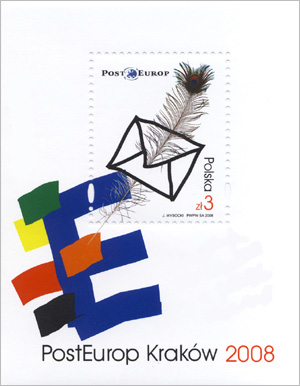
designer: Janusz Wysocki
quantity of stamps: 1 in form of block
denomination: PLN 3
issue: 400.000
printing technique: offset
size of stamp: 31,25 x 39,5 mm
size of block: 70 x 90 mm
paper: fluorescent
date of circulation: 15th January 2008
FDC

Dear collectors,PostEurop Plenary Assembly
On January 16 and 17, 2008 the Plenary Assembly of PostEurop will be held in Kraków (Poland). Such meetings are organized yearly in another Member State of PostEurop. Poczta Polska has already had an honour to host the Extraordinary Plenary Assembly of PostEurop before in its capital city, Warsaw, in 1994. This year's meeting, however, will be outstanding of a few different reasons. Poczta Polska will celebrate then its 450th anniversary, in January the 15th anniversary of PostEurop will be commemorated as well, and the host city will be Kraków, sumptously celebrating last year the 750th anniversary of its foundation. The guests from all Europe will have an opportunity to visit its most important cultural and historical monuments, as well as the world-famous "Wieliczka" Salt Mine.
The new stamp and the FDC envelope
At the PostEurop Plenary Assembly Poczta Polska will present a new stamp in block, specially issued on this occasion. Its artwork combines symbolics of the post (an envelope), the city of Kraków (a peackock's feather, the typical element of the Cracovian folk costume), and the European diversity, expressed in its colour palette, drawn from the national flags of the Member States. The PostEurop logo is present on the stamp as well as on the occasional postmark that will be applied at the Kraków 1 Post Office.
PostEurop - The Association of European Public Postal Operators.
It unites 43 European national public postal operators. It has been established only in 1993, although the idea of joint stamp issues, for example, was born as early as in the beginning of the 1950s. Its Headquarters is located in Brussels, and its activities, such as exchange of experiences, analysis of the European markets and the customer's expectations, introducing the new technologies and the joint legal initiatives is generally aimed to the further development and improvement of the quality and effectiveness of postal services.

